Drømmen om Galapagos
Stein Hoff


Part II
The Pilot Cutter from Sandefjord
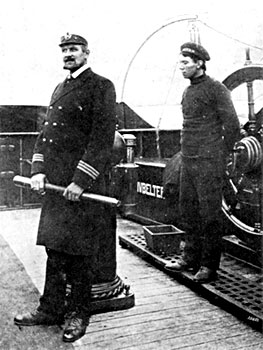
Paul E. Bruun on the bridge of the Neptune during the height of his career. Bruun was the flagship Captain for Bergen Steamship Company before his career was ruined. Photo courtesy Sigfried Bruun Johannessen.
Captain Seeberg was especially interested in learning about the performance of Isabela. For it was he who bought the ex-pilot vessel on behalf of La Compania de Floreana. Originally the ship was named Olav Tryggvasson,§ but like the motorschooner, she was renamed after one of the islands of Galápagos. Besides Floreana, Aug. F. Christensen was of the opinion that Isabela was the most promising island for Norwegian colonization. In his optimistic dreams he envisaged a large Norwegian settlement in Bahia Elizabeth on the west coast and a port town around Tagus Cove—the famous anchorage with 200-year old names of ships painted on cliffs around the bay. When the schooner was named Floreana, it seemed appropriate to name the little cutter Isabela..
§ After the viking king.
The original plan was to transport the cutter on the deck of Floreana, but a long-keeled Colin-Archer is a bulky vessel. Even with all wooden spars dismantled, it proved to be impossible to place the 20-ton boat on deck.
The next plan was to have a freighter from Skien take Isabela to the Canal Zone. Eilertsen would accompany the cutter and take care of her in Colón, Panamá until Floreana arrived. Then he with three or four chosen men would sail her on the last leg of her voyage to Galápagos.
When the Floreana expedition sailed from Sandefjord in May 1925, they thought that the ship with the cutter would follow shortly and catch up with them.
However, on arriving at Colón in July, there was no Isabela, but there was news from Christensen's office about a change of plans. Eilertsen and some men now would sail her all the way from Norway.
In 1925 this was sensational news. Although a few small boats had undertaken long trips, a voyage of more than 7,000 nautical miles in a 39-foot yacht was something very new and daring.
But these plans would not materialize either, because Olav Eilertsen had decided instead to organize and lead his own Galápagos expedition.
In Sandefjord, Christensen has a troubled conscience thinking of his isolated friends on Floreana as well as being pestered by shareholders in his home town. They want to know how their interests are being taken care of.
Newspaper articles continue to give the impression that all goes well with the exotic project out in the Pacific. But Christensen is secretly worried that he is losing the race since unusually bad luck seems to pursue him. He makes innumerable attempts to work out the planned whaling expedition to Galápagos, but he ends up either in quarrels over concession rights, or the ship that he is about to take over is wrecked! Lately, several of the companies that have been whaling along the coast of South America have become bankrupted. He has himself written articles about the large stock of whales both on the east and west coasts of the great continent, but now he is beginning to wonder if the chances of a profitable catch are as good as he assumed them to be.
And telegrams keep arriving in Sandefjord from Seeberg in Guayaquil:
—Where are the whalers?
—How are things with Isabela?
The telegrams make an impression. Regarding the cutter, Christensen decides to do his utmost. He has contacts who know about available seamen throughout the country; there are still many from the days of great sailing ships. In barges and sea cottages along the coast it is surely possible to find a few who could be attracted to the prospects of an adventurous voyage.
Christensen sits down, composes a few letters and telegrams and makes some telephone calls. But there is no advertising. For this voyage he does not want publicity. That the men will arrive safe and sound and with the cutter in good condition cannot be assured. He has to avoid being implicated in a scandal if the cutter is lost with all hands. And therefore, as little talk as possible at least until they arrive safe and sound—assuming he will find four or five men willing to sail.
Not many days pass before Christensen sends out word via the maritime grapevine that he has two men who are interested, a German-Norwegian first mate named Otto Stöcker, and Erling Syringen, an electrician from Slverum who will serve as engineer.
Both impress Christensen as being suitable crew members for such a sailing enterprise, but they cannot sail alone. Stöcker relates that he knows a captain who is blacklisted because of an old suspicion of being a spy, but he is absolutely innocent besides being an excellent seaman. He is broke and will probably accept the job for decent pay. The man's name is Paul Bruun, born in Arendal 53 years ago, but for many years has had his home in Bergen.
Christensen asks his secretary to provide information about Paul Bruun. He proves to be a rather colorful personality. For several years Brunn enjoyed the reputation as Bergen Steamship Company's best captain. He had served on nearly all the company's ships. Before World War I he skippered between Hamburg in Germany, the Norwegian west coast and England aboard Neptune. During the war there were some dangerous passages across the North Sea between Bergen and Newcastle in England. Anyway, he was still best known as the captain aboard the coastal express Mira. He had an exceptionally extroverted and charming personality, was a man of countless jokes and stories; he wrote poems and songs and even performed magic and card tricks. Captain Bruun was the natural center of attention at any party whether it was at the captain's table aboard Mira, in Bergen High Society, or at a children's party with his own family.
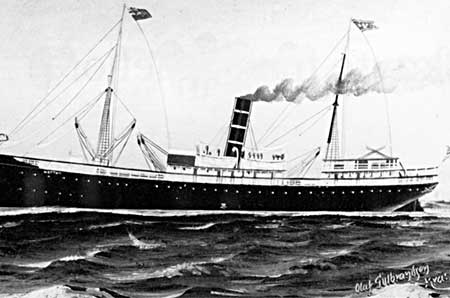
A 1911 painting of Neptune by Olaf Gulbrandsen. Courtesy Per Jarl Bruun Johannessen.
Bruun had an early interest in photography and often had a photographer accompany the ships in order to document beautiful landscapes or distinguished guests aboard. He entertained regularly with slide shows.
In February 1916 the British battleship Hampshire was sunk near the Orkney Islands. There were no eyewitnesses, no survivors. The sinking came as a shock to the allies because aboard the Hampshire was the British Minister of War and former field-marshal, Lord Kitchener. That Lord Kitchener was aboard the Hampshire to initiate negotiations with the Russians at Murmansk, was thought to be a well-kept secret, and only after leaving a British port was the ship given sailing directions. How could the enemy have known about the ship and her important passenger? Could someone have observed the ship and given a report to Germany? The search was on for spies and traitors.
Among the Norwegians, especially along the west coast, there were many friends of Germany. Kaiser Wilhelm himself, with his many visits to the coast and frequent references to Norway in his own country, contributed to this.
Captain Paul Bruun became a suspect. He had contacts both in Germany and England, lived in his luxurious house, “Villa Utsigten,” at Ytre Sandvigen near Bergen. And he was involved with all this photography. It was said that his skipper's salary from Bergen Steamship Company could not possibly account for his high standard of living. Hence, Bruun was arrested and put into jail. This meant that he lost his job and was excluded from the Bergen Skipper Union and Free Mason's Lodge.
Bruun and the other suspects stubbornly denied spying and any connection whatsoever concerning the fate of the Hampshire or other sunken British ships. When the case eventually came up in 1917, the prosecution offered very scanty evidence, but nevertheless won the case. The judge, however, gave only minimal sentences (Bruun was only given probabation). But the citizens of Bergen and the owners of his own company gave him an even harsher judgement: He lost his job and no more was welcome by the town's high society; Bruun was thus condemned by public opinion.
Many years later the Germans themselves revealed what had happened. They certainly had not known about Hampshire's position, but a German submarine, by chance, had laid out a mine-field near the Orkney Islands shortly before the ship was due to pass. Minesweepers which sailed in front probably had failed to do a thorough job because of bad weather. In all probability it was a German mine that sealed the fate of the Minister of War.
For Paul Bruun and his family the years after 1916 were sad ones. He tried to get reinstated as an honest captain, but since he had accumulated large debts and had problems of providing for his wife and five children, he—as did so many others during the prohibition period—started smuggling alcohol. On the Shetland and Orkney islands one could buy the world's best and cheapest whiskey, and the sea voyage back and forth from Bergen in fine weather was a trip of only four to five days. Getting rid of his illegal cargo was never a problem.
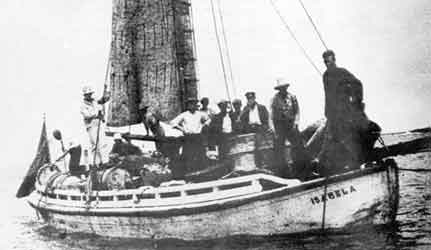
Paul Bruun used Isabela as a freighter between the islands and the continent. Here she is heavily laden at Santa Cruz. Photo courtesy Karen Østmoen.
But in the end Paul Bruun was caught, and any future prospects in a respectable shipping company were definitely lost.
Christensen decided that this candidate met all possible criteria—here was a man who would not be missed even if disaster struck.
Seldom has an expedition sailed with less preparation. Bruun was offered the job of skipper on May 22nd and two days later Isabela sailed for Floreana!
A journalist from Sandefjord's newspaper surmised what was taking place in the harbor, but there was nothing in the paper before May 25, 1926:
“Viking Cruise to Galápagos”
“A pilot cutter sailed from Sandefjord Whitsun Sunday morning at 6 o'clock, with far-away islands as its destination.
“All vikings are not yet dead!
“On Whitsunday morning some of the last vikings started moving down to Galápagos; three men in a pilot cutter. The vessel was purchased last year by consul Aug. F. Christensen, and was charged to the account of the Floreana Company for the purpose of transporting freight between the islands. However, it proved difficult to carry the schooner the long distance, therefore she was left at home.
“But it was evident that M. S. Floreana was too big to sail in Galápagos waters, and that the pilot cutter with its 44-foot length § and 12.80 net tonnage, is, on the other hand well suited to be a freighter between the islands and the continent. For this she is badly needed.
§ Probably this is the length with bow sprit. The hull length is 39 feet.
“Consul Christensen, therefore, decided that the cutter should take the trip out, and that the voyage should not be too hazardous as these cutters are very seaworthy vessels. The trip will surely be successful, provided that one is lucky with the weather; but the three Vikings may well meet hard times before they arrive.
“The day before leaving, we took a tour on board and talked to first mate O. Stöcker. He showed us how much work was involved to stow provisions, oil and fuel. Good work was evident. Even though they had provisions and fuel for two months, there was no noticeable loss of space.
“ ‘You will have a difficult crossing, chief mate,’ we said.
“ ‘Oh, this will only be a pleasure cruise,’ he answered smiling. ‘But I must say that it is pretty amazing to come aboard here since I have just left a 10,000 ton ship.’
“ ‘Do you sail under Norwegian colors?’
“ ‘No, the vessel is Ecuadorian.’
“ ‘Will you sail directly to Galápagos?’
“ ‘That depends, we may have to touch land to obtain more water.’
“ ‘How much time do you reckon you will need?’
“ ‘We should be able to accomplish much in two months' time.’
“ ‘How many are there?’
“ ‘There are three men, captain P. Bruun, engineer Erling Syringen and I.’ Further, Stöcker also declared that they have installed a 14-horsepower motor which will give the cutter a speed of 6-7 knots, but they intend to sail as much as possible.
“We wished them a pleasant voyage and prepared to leave.
“ ‘Oh, do not report any of this in the newspaper until we are well on our way. Action first, then words.’
“ ‘Well, as you wish,’ we promised, ‘and give our respects to Galápagos.’ ”
Two months prove to be too optimistic. Already in the Bay of Biscay they have problems with foul weather and a torn main sail. Reducing sails, going hove-to and other bad weather tactics are tested out but without improvement in the control of the cutter. At this point they simply reef all sails, lash the helm and everything on deck, bolt the hatches and remain below deck. Here they rustle up some snacks in the galley and play cards while the yacht drifts safely and unharmed sideways for three days and nights.
When the sea becomes calmer, and with the help of foresails and engine they reach Funchal on Madeira Island. Here a new main sail is sewn while they do other repair jobs themselves. Days and cash vanish like the dew from the deck as the sun rises over the peaks east of Funchal. When they finally proceed, it is the end of June and the hurricane season is quickly approaching. The cruise across the Atlantic is without incident, but in the West Indies the three men cannot resist the temptation to go ashore. It is September before they start the last stretch across the Caribbean Sea. Now only a few hundred nautical miles remain. Will they succeed in fooling Neptune and reach the Canal Zone without encountering new storms? But alas. They arrive at the fringe of a hurricane. The seas break across the deck taking along mast and sail, lashed down containers of kerosene, gasoline and drinking water. Several times Bruun is convinced that he has seen the stars for the last time.
But the old Colin-Archer schooner also survives this punishment. Finally, Isabela motors in behind the pier of Cristóbal harbor in a wretched condition. Bruun telegraphs a report to Sandefjord asking for money, but receives no reply. Obtaining a loan locally is impossible.
Bruun somehow must raise cash by other means. Aboard Isabela only a few items have not been soaked, but this includes a collection of slides from his time on the Mira. These Bruun has carefully packed in waterproof boxes. Soon he has rented a large hall in the Canal Zone and for several evenings he gives a slide show and lecture about Norway. No seat is empty. The profits are ample for repairing the rigging, obtaining provisions and paying the canal expenses.
This time they do not dawdle. At the end of September Isabela sails out of the Gulf of Panamá.
There is only a brief stop in Guayaquil where they take aboard sacks of mail before setting course for Galápagos where Seeberg and the other colonists are waiting. The colonists know that Isabela left Sandefjord in May and arrived at Madeira three weeks later. But they have heard nothing since then and have feared the worst.
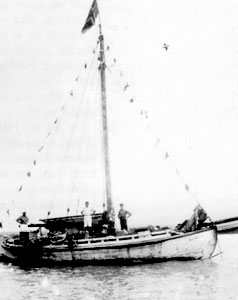
Isabela was a much-needed means of communiction for the colony, but arrived too late to save it. Photo courtesy Robert Ødegård.
But finally the former pilot-vessel arrives. One of the colonists describes the event:
“On October 11th a small Norwegian cutter with a huge Norwegian flag atop the mast arrived here. I must say that Seeberg was so happy that he started to dance and jump with joy … .
Isabela has finally arrived—after a voyage that took twice as long as estimated, yet after a performance by the sailors that Norwegian papers should have praised.”
But not one word was printed back home, perhaps because consul Christensen at this point does not want any publicity about the Floreana expedition. But even the presence of Isabela and the indomitable optimism of Paul Bruun and Axel Seeberg cannot save the colony. The cutter arrives one year too late and the fellows on the island have contracts for only 18 months. The year 1926 has so far presented little more than drought, hardship and privation—they are all suffering from “island fever!”
If only they had a pipeline running down from the springs. Transporting water on the backs of donkeys proves hopelessly inefficient. And even donkeys need something to feed on. After a period of drought there is hardly any grass or a green bush remaining at Post Office Bay. It seems easier to obtain water by distilling salt water than carrying it down from the hills!
Things might have been different had the cutter arrived as planned. Perhaps then some of the men would have remained for a longer period. Even so it is doubtful that the colonists on their own could have earned a sufficient amount to make them financially independent.
The motor schooner Floreana had kept running at a loss. After nine months of activity she has recently been sold to a Colombian shipping company. Anton Stub and crew are on their way back to Norway to celebrate the next Christmas with their families.
Apart from the amount put aside to assure the return voyage of the Galápagos colonists, the company's funds in Sandefjord are irretrievably gone and the company is threatened with bankruptcy and liquidation.
On Floreana, 7,000 miles from Sandefjord, this sad fact is not known for certain; Isabela is anchored in the bay, yet the majority of the men choose to leave. Seeberg however, is firmly determined not to give in under any circumstances. He also convinces Morten Wegger, Oscar Kjøle and Eric Johanson to stay put a little longer. But the others wish to be home for Christmas and as soon as possible want to “move up to Guayaquil,” as they say in Galápagos.
But despite everything, they will first celebrate the arrival of Isabela. And thanks to the arrival of mail, new supplies of tobacco, food and coffee, and above all, Bruun's inexhaustible repertoire for entertainment, the last three days of La Compania de Floreana at Post Office Bay become three unforgettable days.
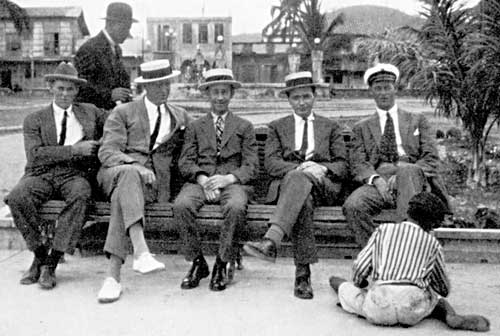
They have had enough. The end of their contract period is approaching and the whaling adventure off Floreana is not materializing. These five colonists—photographed in Guayaquil in November 1926—want to go home and celebrate Christmas in Norway. Photo courtesy Netta Næss.
The Colony at Santa Cruz
At the same time as that first Christmas was being celebrated in Casa Matriz on Floreana, Olaf Eilertsen stands at his window back home in Larvik grieving.
He did not accompany Floreana, and he did not skipper the pilot vessel Isabela. The reason for this he is fully aware of. When he gets stressed, his headaches return, rob him of sleep, make him restless and unable to concentrate. Memories of war play nasty tricks on him. Three times he was torpedoed and rescued in a lifeboat; another time he picked up survivors from another vessel. Still, the worst periods during the great war were when nothing happened, the gnawing fear that maybe something would happen. It was after one of these uneventful voyages that he first felt the throbbing in his forehead.
The pain frightened him. Towards the end of the war the pain recurred more and more frequently. The doctors found nothing wrong but advised him to stay ashore for a while. He was engaged. Why not marry? So in 1917 he married Gudrun Halvorsen. To better his chances for work at home he took the pilot examination in 1918 at Kristiania. After his valiant service during the war he was a well-known and respected man in Larvik. When the Maritime School offered him a teaching job in navigation, he accepted. Gradually, the headaches became less troublesome. Only rarely, when duties and stress accumulated, did the pain and the clammy fear return.
While Floreana lay in Sandefjord and the purchasing of supplies and equipment and 1001 preparations were at its most hectic, Eilertsen did not always manage to adhere to arrangements and schedules.
When Aug. F. suggested that he should transfer the responsibility for leadership to Stub and Seeberg, at first he felt relieved.
Not so when whispers and rumors start, then he has regrets. “Confound it!” Eilertsen stares into the garden biting the stem of his pipe so hard that it cracks. The evening's snow has already turned to slush. The wind shakes the leafless apple tree, the skies are dark and dreary. And here he remains —instead of working with friends in Galápagos, helping to build up a colony—he is a stay-at-home, restless and without steady work. A week ago he read a long article by Ludvig Næss in the Østlandsposten. Never in his life had he felt as jealous as after he read about the colonists' fascinating life.
In the documents of the Floreana Company, he was still named as second in charge ashore, but the chief clerk in Sandefjord, Dagfinn Prebensen, absolutely refused to pay him the monthly salary of kr. 185. Prebensen's arguments were understandable since Isabela still lay in Larvik harbor. But was it not he, Eilertsen, who was the brain child and originator of the whole enterprise? But the stupid Prebensen rejected such arguments. And it was unlikely that it would be easier to argue his case with Aug. F. himself back in business. He did not look forward to this meeting.
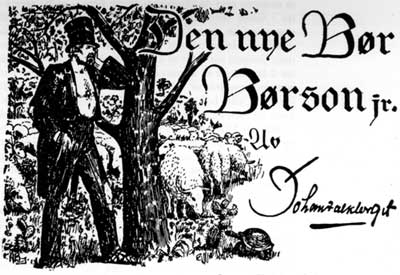
Børson as shepherd on the island of Floreana. Has his lucky star vanished from the horizon?
Northeast of Post Office Bay on the island of Floreana, a gentleman is seen in top hat and tails, whip in hand, shepherding a flock of sheep. He wears no shoes. Around his feet he has wrapped bits of goat skin held together by hemp rope. He is somewhat thinly dressed. No shirt under his coat, and his knobby knees bared through holes in the trousers. Collar or tie?—not at all! It would be a mistake to suggest that he was cold—quite the contrary. In fact, he becomes sweaty from time to time.
Evening approaches—still the sun is directly overhead—this is a strange phenomenon that he cannot quite understand. For long periods he stands with mouth open and stares dumfoundedly straight into the air. Is this a different sun that the none that shines on Olderdalen? Yes indeed, the genteleman in top hat and tails is Bør Børson. After much travelling and many strange happenings he has finally landed on Galápagos. That he arrived here is nothing less then a miracle.
The journey took all of two months. For the first time in his life he has experiences what it means to be both hungry and thirsty.
More than one Børson regretted leaving the stewing ports of his native Olderstad.
Aboard Norwegian Hills Børson first had to endure a lot of teasing and slandering—indeed, several times he was the subject of an outright beating. In the beginning he wept and prayed for forgiveness—he ran like a beaten rat from morning to night. However, one day it dawned upon him that instead he ought to face his tormentors with revenge. From this time on Børson started showing his fists. And he did this so sucessfully that he quickly became the terror of Norwegian Hills. He started one night by beating up the cook in the galley. After that success, he dealt with the others one by one. First and Second Mate were singled out on deck. He might have beaten them to death had the Captain not come running from the bridge with a raised revolver. From that time on he was only referred to as “Meat Cleaver”—a nickname that one dared not mention in his presence.
Bør Børson was also attacked by “Galápagos Fever.” In a little-known continuation of the popular story about Børson, Falkberget § lets Børson go bankrupt before joining the expedition to Floreana. He is hoping for a lucky break—while escaping the claws of his creditors in Olderdalen. After a lot of hard work and many adventures, Bør in fact discovers a pirate treasure and returns as a wealthy man. Again he can serve his friends “Champagne, first class only, second never!” Falkberget called this story about “The new Bør Børson Jr.” a literary emergency. He had given in to incessant public demand, but only agreed to write more about the popular figure if it was guaranteed that it would never be published as a book. “The New Bør Børson” was printed as a regular series in the Magasinet for Alle ( Magazine for All).
§ Johan Falkberget (1879-1967) was a successful author, basing his stories mostly on the mining and farming communities around his native Røros. His satirical stories of the fictitious Bør Børson became extremely popular. Bør was the seemingly simple farmer's son who became a local big shot in business, having started with a tiny shop. However, like almost everyone else, Bør went bankrupt in the late 20s, and tried to make a new fortune by joining one of the Galápagos expeditions.
Eilertsen's wife, Gudrun, was not particularly happy, either. Two small boys were to be cared for. It was now over a year ago since he gave up his job at the Maritime School in order to pick up Floreana in Sweden. All the savings are now used up. Occasionally the school needs Eilertsen as a replacement, but Gudrun has to take in sewing work to make ends meet. Her husband spends most of his time at the Seaman's Home. Also in the house he is mostly with his books and charts, smoking and brooding.
It is on this Christmas Eve, 1925, while standing at home by the window and staring into the deserted street, that he makes up his mind: “You have only one thing to do,” he tells himself aloud. “Forget all about Floreana and Christensen—form a new company! And make sure you are the boss and leader from the very beginning!”
Plans for a new expedition had been dormant in Eilertsen for quite some time. There were several who had proposed it when Floreana sailed, but he had doubts about the outcome of the first expedition, for after all, it was an experiment. But after all the excitement produced by the newspaper accounts, he no longer has any doubts. The colony could not fail! And if one expedition made it, another should also succeed. There was enough room in Galápagos. Santa Cruz Island, where the men of Alexandra had been stranded, was essentially uninhabited. From his first talks with Herman Karlsen, that is where he wanted to be. And as far as he was concerned, both the island and Alexandra's gold still lay there, untouched and waiting.
Christensen did not dare take all the equipment for a canning factory with the first expedition. Now it is his turn to make plans a reality. And with two to three times as many men as on the Floreana expedition, they would soon catch up with Christensen's head start.
Gudrun Eilertsen did not need to be persuaded. She was also tired of all the gossip. As soon as the little ones, Eilert and Arne, were asleep, she sat down with her husband and composed an advertisement. On the second of January, 1926 it appeared in the Oslo newspapers and several other newspapers throughout the country. It announced the establishment of a company whose objective was much like that of the Floreana company, namely, colonization and exploitation of the riches of Galápagos. On three important points the new expedition would be different: it would take along a prefabricated canning factory, it also offered space for a limited number of women and children, and last, but not least, there would be the fewest possible shareholders over and beyond those participating in the expedition. In this way most decisions could be made by the colonists themselves.
The response was overwhelming. During the month of January, more than 150 written enquiries were received. Eilertsen had his hands full just answering letters and inviting as potential shareholders those he considered to be suitable members of the expedition.
One such reply, dated Larvik, Feb.4,1926, was sent to Mr. Thorolf Østmoen, Opland Hotel, Drammen:
In answer to your letter of yesterday, I forthwith send you a shareholder invitation which, you will see, sets forth the purpose of the company. In addition to the sharing of profits, as described, there will be a monthly salary, probably from kr. 500 to kr. 200 according to a person's age, experience and other qualifications. Each active participant contributes kr. 3,000 thereby forming the company. As there will be no shareholders other than participants and manager, all that we accomplish will be to our own advantage. If you would like to come here to confer, my address is Nansetgaten 27.
Yours truly, O. Eilertsen.
The manager who is mentioned was Tryve Hyenæs in Tønsberg. It is he who some days later received Østmoen's shareholder's invitation already signed. The next letter to Drammen is dated 9/2/26 (Feb.9th) and is sent by the manager.
“Referring to your subscription for a joint-stock venture, I beg you to pay kr. 3,000 against a temporary receipt to Tønsberg's Industry and Sjøfartsbank. There are so many wishing to participate that we have to give preference to those who pay first. It is important to get the expedition on its way, and the sooner the better.”
Larvik, 3/3/26
Mr. Th. Østmoen,
Drammen.
Concerning personal equipment for Galápagos expedition.
Warm clothing should be taken along for use only for the first 3 weeks of the voyage. For those who will be ashore, it is necessary to have thick leather shoes with leggings or high-cut boots.
Of thin summer clothing and shoes, one should take along what one already possesses, and purchase, if necessary, more in Panamá.
Of bedding, one should take a few woolen blankets, quilts, a few bedsheets and pillows, 1 mattress, size about 180 × 70 cm (72 × 28 inches), or a ready made mattress cover which can be filled § here before departure.
§ with hay
Of dishes: bowl and flat plate, coffee cup, knife, fork, spoon and teaspoon, preferably two of each. Towels and shaving kit for personal use.
If somebody has a camp bed or firearms such as a rifle, shotgun or revolver, it is desirable to bring these along.
The plan is to erect small houses with two rooms in each. Two wooden bunks about 180 × 70 cm. (72 × 28 inches) will be constructed for each room. Those who can bring along a camp bed can use it instead of a bunk. On arrival in Panamá everyone will have to purchase a mosquito net to be hung up over the beds. This costs about 2 dollars—about kr. 9.50.
Concerning the need for light-weight clothing, one does not need to buy much in Panamá initially as we will often have contact with the continent where we can obtain all kinds of things as we need them. Those who have the opportunity should exchange about kr. 100 to American dollars ($21) before departure. For the others, the company will take along sufficient cash so that those who might need it can get an advance in Panamá to purchase necessary items.
If you have other items that you think would be of use to you over there, for example, tent, tools, instruments, books, etc., just bring them with you.
Yours respectfully,
O. Eilertsen.
After buying shares in La Colonia de Santa Cruz, members get last-minute instructions about preparations and equipment. Letter courtesy Karen Østmoen.
During the winter, Galápagos fever grew to epidemic proportions. Christiansen was back in Sandefjord and so far pleased with the situation in Floreana, and Alf Wollebæk and taxidermist Erling Hansen were back at the Oslo Museum with an outstanding collection of animals and data. In addition to interviews and comments from these returning gentlemen, the newspapers printed enthusiastic Christmas greetings from the Floreana colonists. Aftenposten devoted the entire front page of the Saturday edition to Galápagos; the humor magazine Korsaren published a large drawing depicting “Daily life on Galápagos.” Here one sees how “King Aug. F.” governs the island of Floreana from his mobile Galápagos throne, while naked black women entertain with hula-hula dancing. “Bathing suits” in the shape of fig leaves can be rented, and one can get warm whale showers for 50 cents. Another amusement is the racetrack for centipedes.
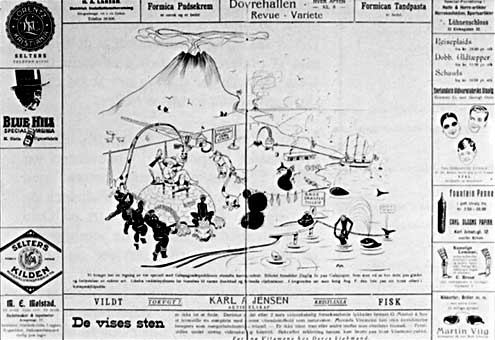
During the first half of 1926, news about the interesting Norwegian emigration adventure on Floreana was good copy for newspapers and weeklies. Here the humor magazine Korsaren describes “Daily life on Galápagos” with “King Aug. F. the 1st on his throne, constructed like a giant tortoise.”
On February 22nd a constitutional general assembly was held at the Seamen's Home in Larvik. Eilertsen and Hyenæs led the meeting. Eilertsen read aloud from the three-year-old report and the invitation for immigration from Christensen, and showed a bundle of newspaper clippings about the Floreana Company, read extracts and explained about the islands' magnificence. The mood of the meeting was electric. The proposed name was accepted with applause: La Compania de Santa Cruz.
Eilertsen first planned an expedition of about 30 members. But before long he had made up a list of about 50 people, including four or five families. How could they finance a ship large enough to accomodate all these people?
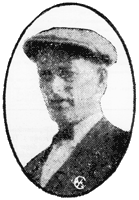
Luck was now on Eilertsen's side. The “fever” also attacked a captain in Oslo, Alf Gude Due. In March he had purchased Alatga, an older American-built wooden schooner, now registered in the small town of Tvedestrand.
Skipper Alf Gude Due bought Alatga and talked Eilertsen into enlarging the expedition to include two ships. Photo from a newspaper clipping.
> Gude Due knew that Eilertsen had received more than 500 enquiries and could easily fill another ship with colonists. He offered himself as a partner. His offer was presented in a rather unorthodox fashion, being first printed in an interview in the Aftenposten, March 23. There he also states that Eilertsen has purchased the motor-schooner Ulva from R.O.Helgesen's Shipping Company in Porsgrunn, and that the planned date of departure is April 15. In the Østlandsposten next day there appears a denial from “a very indignant captain Eilertsen.” He certainly has no wish to cooperate; Ulva has not yet been purchased.
However, in a circular letter to the members of the expedition three days earlier, it was stated that Ulva had indeed been purchased for kr. 57,500. Why Eilertsen now denies this to Østlandsposten remains a puzzle.
Concerning Gude Due's proposition for partnership, one may assume that he already had approached Eilertsen with an offer of cooperation, but was turned away. The Oslo captain's statement in Aftenposten might represent a new tactic—probably contrived through discussions with Hyenæs, the manager. Gude Due happens to be engaged to Molly Hyenæs, the sister of the manager!
When Eilertsen simmered down, the events in fact took place almost exactly as Gude Due had suggested. Without a doubt, Trygue Hyenæs played an important role. It was he from the start who managed the finances. Another ship within the same company meant a doubling of the share-capital and, as far as he was concerned, greater scope and commercial advantage.
Eilertsen grudgingly agreed with the arguments from Tønsberg, but not before Gude Due made it clear that Eilertesen would always be leader-in-charge. He was happy to remain the captain aboard Alatga and to see an old dream about Galápagos become a reality. Besides, he would soon marry Molly, and he wanted her to come along on the voyage to the west. He could not imagine a better honeymoon.
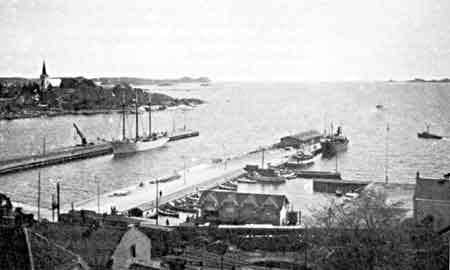
Trygve Hyenæs was now listed as the official owner of both motor schooners.
Ulva at the Eastern Steamship Dock in Larvik, where it is being readied for the expedition. Photo courtesy Robert Ødegård.
During April, satisfactory cooperation was achieved between the two parties of La Compania de Santa Cruz. Now more expedition members could be accomodated. There was space for 43 people aboard each ship, 86 altogether. Berths were installed together with other changes at the Larvik Mech. Shipyard and the Kaldnes Mech. Shipyard in Tønsberg. To save money, most of the work was done by the expedition members themselves, especially at Tønsberg. In Larvik so many of the shipyard inhabitants had family or friends taking part of the expedition that many of the shipyyard employees and other locals worked without pay. Local purchases were made at very favorable prices. Several national firms also supported the enterprise; Lilleborg Chemicals with soap and cooking oil, Freia Chocolate Company with cocoa and chocolate, Jordan Company with various kinds of brushes, from toothbrushes to mops, and the Oslo Sailcloth factory with canvas.
Of the two ships, Ulva was undoubtedly in better condition. Recently she had undergone extensive repairs and improvements after a minor shipwreck, and she could now exhibit the Veritas Insurance Company's prestigious classification of “A-1 with star,” that is, first class.
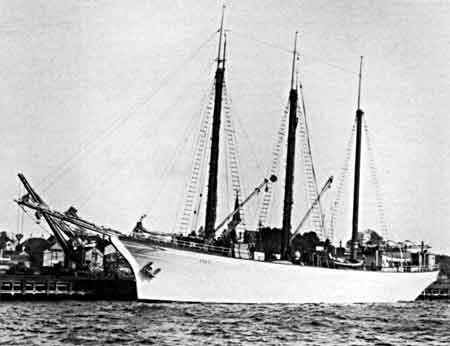
The wooden motor-schooner Ulva was constructed at the Brastad Shipyard, Vestnes, in 1919. She was 38.9 meters (128 feet) long and 360 tons gross. The schooner was newly overhauled and classified “A-1 with Star” by Veritas. Photo courtesy Arne Eilertsen.
On the other hand, Alatga's rigging and engine were sadly worn and in need of thorough repairs. It was therefore decided to have a one-month interval between departures of the two ships. Ulva would be first to leave and carry out some of the preparatory work in Galápagos, such as starting construction of the canning factory. All families with children would sail aboard Alatga and, hopefully, find a well-organized colony on arrival in Santa Cruz.
But Ulva's departure was continually postponed. In early May nearly all shareholders were either aboard the ship or in boarding houses nearby. The number of participants had increased to 45. It was only after a heated discussion at an extraordinary general meeting that it was agreed to let two women who were not shareholders to be included, namely Mrs. Marie Dahl, married to Helge Dahl from Oslo, and the student Borghild Rorud, also from Oslo. The latter had received a grant to stay in Galápagos for some months to collect plants for the Botanical Museum.
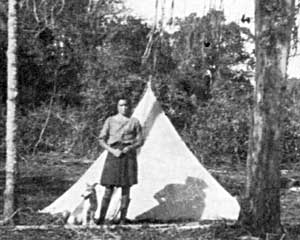
Student teacher Borghild Rorud was not a shareholder in the company but traveled on a grant to collect plants for the Botanical Museum in Oslo. She lived in a tent on Santa Cruz for about four months and returned to Norway with a unique collection. A tree, Acacia rorudiana, is named after her. Photo courtest Borghild Rorud Rambech.
On May 9th there was a trial trip on the fjord which included adjustment of compasses.
That same evening yet another general meeting was held. The first item on the agenda was the contract for the canning expert. He did not have the kr. 3,000 which were demanded of the ordinary shareholders, and he did not wish to assume a big debt. The result of the discussion was that he accepted a contract tying him down for three years with a yearly salary of kr. 7,000. If production prospered, he would later receive a percentage share from the sale of the canned goods. The share capital of kr. 3,000 was to be paid gradually in amounts of kr. 1,000 to be taken from his yearly salary. Still he should be treated as a legitimate shareholder and co-owner of the company.
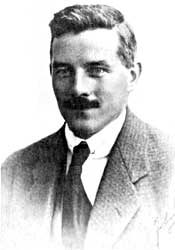
The canning expert's name was Martin Skaraas. Currently he was employed at Bjellands Factories in Engelsviken, Stavanger, but for several years prior to that had been canning foreman at Kamchatka and Vladivostok in East Russia. He was a restless person who loved to travel. His wife and three children were accustomed to the fact that he was rarely at home. He compensated partly for this by frequent letterwriting and daily detailed entries in his diary. In due course his family (and posterity) could participate in his many strange adventures around the world.
Martin Skaraas from Stavanger had experience as a canning operator in eastern Russia with the Norwegian Bjelland Canning Company. Photo courtesy Thelma Lea.
In his diary entries for these days in May, Skaraas expresses frustration with all the delays. He and several others begin to realize that poor finances are becoming a big problem for the expedition. They realize that the monthly salary, which was agreed upon, will be delayed until they start earning from the factory and fishing in Galápagos.
Each day's delay means a reduction in the precious provisions, and further postponement for when money can be sent home to Norway. Many have fianceés and wives who they plan to send for after a year or two.
The bachelors, who are in the majority, are not concerned about delays. They have a wonderful time when Larvik's young ladies, along with many others, wander to the quay to see and hear how the big expedition to the South Sea is progressing.
Eilertsen is sporadically seen aboard ship, mostly as guide for interested journalists and Larvik's more influential citizens. The obvious chaos on deck frightens him a bit, but he leaves most of the responsibility to the first mates, the brothers Edvard and Alfred Andersen, who are also from Larvik. Otherwise he is mostly at the Seamen's Home or at his house in Nansetgaten.
It dawns upon Eilertsen that he will have to part from his sons, five and seven years of age. Soon he will be 47. Who knows if he will live to see them or his wife Gudrun again? His headaches return but he supresses them by talking, moving around, and celebrating in town. One farewell party follows another. But now some of the expedition members are becoming impatient. Early May 16th Eilertsen reluctantly travels to the Ecuadorian Consulate in Sandefjord. All expedition members must have their visas stamped in their passports.
Eilertsen has dreaded this for a long time. He is visibly relieved that Aug. F. Christensen is not present, the chief clerk instead taking care of formalities. Then he visits Hyenæs' office in Tønsberg, gets cash in the form of American dollars, and is back in Larvik before mid-day. Everything should be ready for departure by 16:00 hrs.
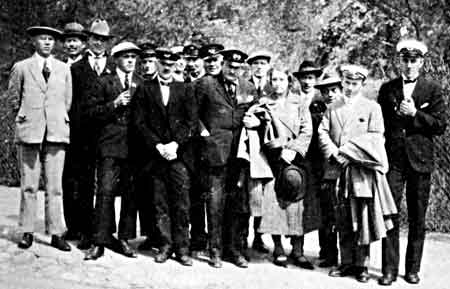
Sixteen of the 45 expedition members of Ulva in front of the church at Larvik a few days before departure. From left to right: Jens Moe, Sannidal; Henrik Furunes, Ekne; Thorolf Østmoen, Drammen; Lars Karterud, Blaker in Akershus; Karl Johansen, Halsøy; Martin Skaraas, Stavanger; R. Fogh, Oslo; Hjalmar Jensen, Halle; Thorolf Larsen, Fredrikstad; Olaf Eilertsen, Larvik; Helge Dahl, Marie Dahl, Sverre Kiserud, Oslo; Birger Rostrup, Mandal; Mathias Breivik, Holmestrand; Herman Hansen Vik, Porsgrunn. Photo courtesy Thelma Lea.
In town news spread with unbelievable speed. Several hundred persons gather at the quayside when Ulva starts pulling in the warps precisely at 16:00 hrs. But where is Eilertsen? Just before the gangplank is hauled in and the last warps loosened, a car appears at full speed. It stops and out jumps Eilertsen. He runs aboard and looks peeved at first, but once behind the wheel his face lights up.
People wave flags and shout “hurrah” and sing the national anthem. Finally Ulva is cast off and heading south.
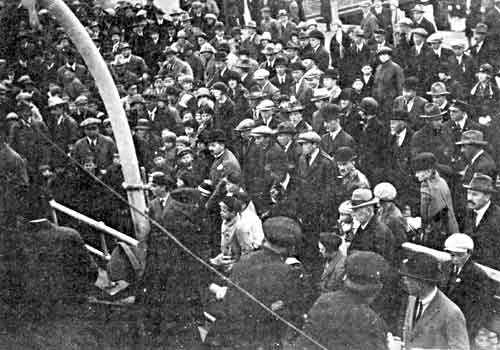
There is flag-waving, cheering and singing of “Ja vi Elsker”
(Norwegian National Anthem “Yes, We Adore … ”). Photo courtesy Thelma Lea.
With Ulva across the Atlantic
Ulva was lucky with the weather and the expedition had a good start. Not until they passed through the English Channel and approached the Bay of Biscay on May 21st did they experience rough sea. By that time everything aboard was shaken into place and was safely stowed away, and “green” expedition members had started acquiring their sea legs like proper seamen. With the successful start, good humor prevailed. “Much fun” became the trademark for the entire crossing. Even Eilertsen's nerves quieted down as soon as he felt the moving deck beneath his feet. And if some people had doubts about his ability as a leader during the hectic last days in Larvik, they now had to admit that he was a man capable of creating a happy and relaxed atmosphere among the 44 people he was responsible for.
But otherwise Eilertsen did not hesitate to remind everybody how privileged they were to be part of this most popular expedition. Before the start of the expedition the number of applicants was nearly 1200. Just the last day 100 enquiries arrived!
The National Day, May 17th, is celebrated with song and festivities on the foredeck. Later this is where the singers and orchestra meet for practice and “concerts.” Also it is here that one may dance or just listen to a hand-cranked Victrola. Understandably the place is christened “Ulvebakken.”§
§ Ulva was the name of the ship, but it sounds like “ulv,” meaning wolf. “Bakken” is the open space on the foredeck of a ship. But “bakken” also means “hill.” Thus, we have a play on words, “ulvabakken” meaning “wolf hill!”
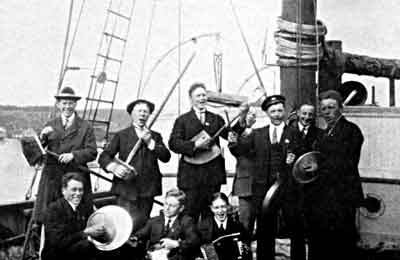
The Ulva Jazzband is popular on “Ulvebakken.” Standing, left to right: Jens Moe, O. M. Hansen, Oslo; Thorolf Østmoen, Lars Karterud (nearly hidden), M. Th. Nielsen, Drammen; E. Beckmann, Frederikstad; Axel Helgesen, Bodø. Sitting with accordion: Rolf Halvorsen, Larvik. The identity of the other two in front is unknown. Photo courtesy Erling Brunborg.
On May 25, as the Bay of Biscay disappears behind them, the weather gets noticeably warmer. Everyone is delegated to a group for night watches and work. The two motorboats on deck have to be repaired and painted. The wooden material for the factory and seven smaller houses must be cut and numbered. Ulva also needs attention with rust removal and touch-up painting.
Bottlenose porpoises and other dolphins daily dart back and forth beneath the bow. Under the pretext of lack of food, Karterud harpoons one of the animals and drags it aboard while the others cheer. Next day “bottlenose steak” is on the dinner menu.
On the 29th, Madeira appears on the horizon. It is too dark to distinguish details on land, but the offshore breeze brings a bouquet of exotic and exciting fragrances which tests the self-control even of experienced sailors. There is no talk of any other action than to have the anchor dropped off the port of Funchal before the midnight watch.
Excitedly they signal for a pilot but to no avail. Lacking a searchlight, second mate Christoffersen fires off rockets. This provides light of a fashion, and slowly they approach the roadstead. But one of the rockets hits the jib and immediately sets it ablaze. Thorolf Østmoen decides that this is overdoing attention seeking, jumps up onto the bowsprit with a pail of water and douses the flames. Christoffersen starts firing rockets again. Around midnight they finally drop anchor. Before he goes to bed, Skaraas notes tersely in his diary: “It was a strange sight coming in with the bow ablaze.”
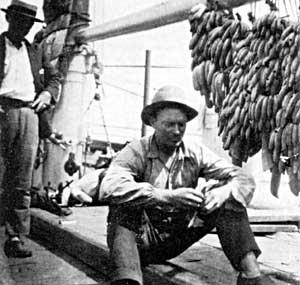
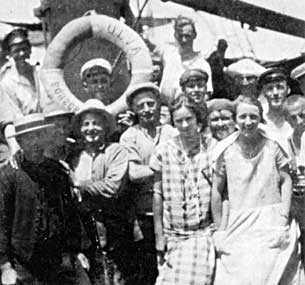
Left: Thorolf Østmoen sitting beneath newly purchased bananas from Madeira. His personal bunch is attached to the top of the mast—the only place, he claimed, where he could eat them in peace. Photo courtesy Karen Østmoen.
Right: During the entire cruise across the Atlantic there was optimism and a good mood. The female participants were Borghild Rorud and Marie Dahl, both from Oslo. Photo courtesy Thelma Lea.
After Madeira they go to the Canary Islands to refuel. On June 10th they move into the Atlantic proper making a course for Panamá. They have a good running wind from aft. Some hours after leaving Las Palmas,“the gaff on the main mast broke, the crew cheered because they believed that they would be served 'gaffelbiter' (gaff morsels) for supper. Instead, there was tuna which Kaare Urholt harpooned—but fish, nonetheless.”
The northeast trade winds push them westward no less than 150 miles a day. In the morning, flying fish can be collected on deck. It soon is too hot for comfort below deck and many move their bedding top-side.
The ship's newspaper, named Gapa-Lagos § is published at irregular intervals. “Nr. 1, First Edition” is dated May 29th. The publishers are Østmoen and Eilertsen.
§ “Gapa” is a yawn—a play on the word Galápagos.
It contains jibes about this and that. A few extracts:
“Radioprograms”
7.a.m. Roar from the bridge by Alfr. Andersen.
8 a.m. 30 leaders give orders to 12 men.
12 noon. Common complaint about too much fresh food.
8 p.m. Untimely signal by Kiserud.
8-9 p.m. Play by those who cannot.
9:15 p.m. Lecture by Captain Andersen on maritime style and maritime work in the past, present, future, and preferably not at all.
10 p.m. Happy hour with mandolin performance by Berg§§ and wife.
11-12 p.m. Dancing music from Forge Hotel.
§ More play on words. Instead of Dahl (valley) they write Berg (mountain).
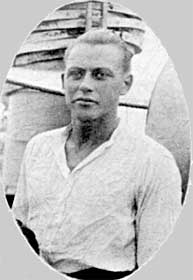
News
“Our town, Ulvenø (Wolfisland), had a pleasant surprise yesterday with the announcement of harpooner Karterud's splendid catch, which immediately transformed our town into a better financial condition. At the same time, Mr. Karterud, the harpoon “caster” applied for a name change to Kasterud. The wish was granted without delay.”
Lars Karterud from Blaker in Akershus. Twenty-two years later he also participated in the expedition aboard Thalassa. Photo courtesy Ingeborg Faller Mjelde.
Useful work is accomplished during the crossing of the Atlantic. Before reaching Cristóbal and the Panamá Canal, all wood is cut to length and numbered. Approaching the Caribbean Sea they have a midsummernight party on “Wolfshill.” It is the day after full moon and nearly as bright as a summer night in Norway. The trade winds are steady and their expectations are raised as full as the sails above them. The engine is running all the time and frequently Floreana does 8-9 knots. Long tropical moonlit nights seem filled with magic. Some sit on deck in Madeiran basket chairs talking, exchanging stories, or singing. Others lean across the railing admiring the dolphins' phosphorescent trails in the water. No wonder it is difficult to sleep.
They pass close to Barbados and St. Lucia, allowing the navigator to ascertain their position before setting the final course for Cristóbal. They arrive at the Panamá Canal on July 4th, 24 days after after leaving Las Palmas. After putting ammunition and dynamite aboard the canal train, as required by regulation, they pass through the Canal the next day.
Unknown to most of the expedition members, the ship's financial reserves are nearly exhausted. Far too much of the capital was used before departing from Norway for general purchases, repairs, travel and entertainment. And now they have to pay US$ 550 for the canal fee and pilotage. They also need diesel fuel, water and provisions. To cover these expenses they have to borrow a large amount. Alatga, which belongs to the same company, is registered as one of the guarantees. A telegram from Hyenæs announces that the schooner sailed from Norway on June 7th, slightly more than three weeks after Ulva, and that she should be in Panamá within a month.
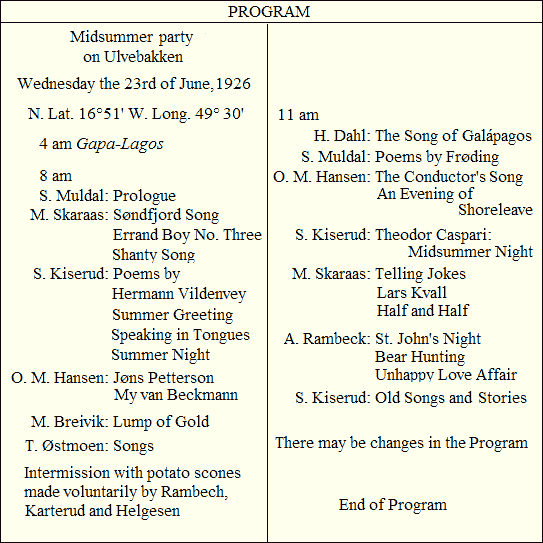 Midsummer in the Trades was celebrated with folksongs, jokes and story telling, poems and other entertainment. Program courtesy Arne Eilertsen.
Midsummer in the Trades was celebrated with folksongs, jokes and story telling, poems and other entertainment. Program courtesy Arne Eilertsen.
Along the coast of Panamá the Ulva expedition experiences proper doldrum weather with daily rain, lightening and thunder, humid heat, little wind and poor headway. Together with the financial worries, this puts a damper on the mood. Even when they cross the Equator on July 11th, there is not much activity on deck. There are so many candidates to be baptized that there is no King Neptune ceremony. Martin Skaraas notes dryly in his diary that “today I am 43 years old, we passed over the line. Nøkken would not appear.§ There were too many people.
§ Nøkken is a Norwegian troll who traditionally lives in lakes. He lures, scares and sometimes eats people who venture too close, thus explaining a lot of drownings.
On the 14th of July they anchor off Puna, Ecuador. The next morning they are piloted up the Guayas River and anchored by Guayaquil at mid-day. Eilertsen goes ashore alone to arrange clearance with the authorities, get mail and money, and look for Mr. Carl Sund. This businessman from Oslo has travelled ahead to arrange the company's concessions on Santa Cruz and to find an agent in town.
It is a long time before Eilertsen returns, depressed and disheartened. He has a lot of mail with him but no money, and knows that according to Sund, nothing is arranged. For the time being Eilertsen keeps this to himself.
On July 18th Sund arrives on a visit. All are gathered together to learn about the concessions that he was to have approved. Skaraas recollects as follows:
“Mr. Sund comes aboard, he is the father-in-law of Hyenæs. He is sent down here to help with the concessions and to see the islands. He gave a tear-jerking speech about the “Fatherland,” and that they should not loose heart but must remember what Roald Amundsen did for Norway. He will not come along but return home from here. This is only a pleasure trip for him, paid with our money. Everyone is very angry at him and he was so informed, and therefore he will not dare to come along.”
Things go badly for Eilertsen. For these three days he has known that nothing is arranged and that the money situation is precarious. He does not speak English well and no Spanish at all, and for the time being he sees no way out of the difficulties. The headaches return, worse than ever; he feel giddy and weak. At night the scenes of war's terror return and he awakens from the nightmares, drenched in perspiration.
He tries to suppress his worries and helplessness through guarapo, the local sugarcane liquor. Aside from his daily trips to the consulate to look for mail and ask for money, he spends most of his time in the harbor pubs. He rarely shows up aboard Ulva.
On the 20th of July a general meeting is called. First, a letter is drafted to Sund in which he is strongly criticized for his miserable effort and and he is denied funds from the company's account for the return voyage. Thereafter, Eilertsen is removed as leader “on account of illness.” The new leaders are Captain Edvard Andersen aboard Ulva, and Kaare Urholt ashore.
The foreman of building operations, O. M. Hansen, announces that he is withdrawing from the company. Through consul Bryhn he has found work building open fireplaces, after which he wants to return to Oslo.
It is Bryhn who arranges for a provisional concession on Santa Cruz. In addition to the usual 50 hectares for each colonist, the company “may choose two bays.” Two Ecuadorian officers will accompany Ulva to map the properties.
Finally, after telegraphic reminders, one thousand dollars arrive from Hyenæs. Only then could they pay the pilot who guided them up the river, purchase fuel, and take on fresh provisions. But there is not enough to pay off some of the debt incurred in the Canal Zone.
On a brighter note, the Ecuadorian Navy is interested in purchasing Ulva for a reasonable price. This should free considerable capital.
Eilertsen is deeply hurt on hearing the news about the change in leadership; he has a sort of collapse. A couple of men have to stay with him for 36 hours until he recovers. Afterwards he stays off the liquor, seems less depressed, but clearly he has lost his drive and enthusiasm.
Before the expedition gets underway on July 27th, they have had nearly two weeks in Ecuador, a period which, in more ways than one was very costly to the expedition.
To Santa Cruz
All breathe a sigh of relief when Ulva finally leaves Guayaquil. Hopefully the biggest obstacles are overcome. A large store of provisions is now aboard. They feel capable of managing their own affairs well as soon as they are safely in Santa Cruz and can go about their own business unhindered.
In Guayaquil they took aboard a passenger with first-hand knowledge of the problems of the Floreana Expedition in Post Office Bay. As mentioned before, Captain Axel Seeberg travelled to Guayaquil to prevent a complete collapse of the Christensen expedition. Now he has a chance of returning to Galápagos after an absence of more than three months. He does not know if provisions have arrived at Floreana during his absence, and naturally he is concerned about his isolated friends.
The crossing from Guayaquil to San Cristóbal is quick and without any problems. As they know from recent experience, the weather situation around the Equator is very variable, but now Ulva is sailing with a welcome and relatively cool breeze from aft. The temperature falls a few degrees both in the air and in their minds. A few starlit nights with a phosphorescent sea and dolphins, and music from 78 rpm records played on a hand-cranked gramophone on “Wolfshill” bring back tranqulity, hope and confidence to the expedition members. They will make sure that they do better than the group on Floreana!
On August 3rd Ulva sails to Floreana after having first called at San Cristóbal to report to the authorities and to meet señores Alvarado and Cobos.
In order to arrive at Post Office Bay in the early morning, the crossing between the two islands is made after dark. The wind is favorable, the strong current with them, and they round the north side of Floreana before daylight. Here, the whole expedition nearly ends with a disaster.
Mathias Breivik is positioned in the bow as watch, but he is so fascinated by the luminous trails of fish and dolphins immediately below him that he does not see the black shapes ahead. It is the helmsman's sixth sense that registers a change in the movement of the sea. He glances forward and gets a shock when he sees black rocks, but has enough presence of mind to throw the helm over in order to turn the ship to starboard as quickly as possible. Ulva is fully loaded and heavy and reacts very slowly, but finally she turns into the right direction. The rocks rush by closely to port side.
The remorseful Breivik is sorry and shaken as he receives a mouthful of curses from the helmsman.
Ashore seven Norwegians and a handful of Ecuadorians, perform a wild dance of joy at the sight of Ulva gliding into the harbor of Post Office Bay. The ship is handsomely dressed in signal pennants and national flags, a sight bringing tears to many a nostalgic eye. Mail, tobacco, provisions and the company of countrymen, especially those of the opposite sex, make them forget all their problems for the time being.
Jens Moe aboard Ulva writes home to his mother in Sannidal:
“The same day we arrived we were invited ashore. In the evening, a grand party with singing, dancing, music, speeches, whiskey—bonfire and lobster for dinner. A very enjoyable party after the long journey at sea. We stayed for 4-5 days, surveying the island.”
Regarding different reports about the island, they vary to such an extent that one wonders if they describe the same place. Galápagos is so full of contrast and peculiarities that what attracts one person may well repulse another. Take, for example, carpenter Henrik Furnes' version, also in a letter home:
“On Floreana we roamed the hills for three days and, as on San Cristóbal, here are lots of wild cattle and pigs. The inland hills on this island are often overgrown with citrus trees. We also saw a beautiful banana grove, but otherwise there are no useful fruit trees. The island looks very dry and desolate and the water situation is difficult because there is no brackish shore-water. Up by one of the highest hills, a small spring surfaces, enough for a large household, but it soon disappears into the ground, and to get there from the main house means trudging over rubble and boulders for more than two hours.”
Martin Skaraas was more impressed by the island and considered it exciting, especially the pirate cave near the spring, where he found the date 1648,§ and other natural caves that the Norwegians had discovered. One such was located very near Casa Matriz and was first found by Rolf Sønderskov while digging up tree roots. At first they were disappointed that neither yielded a single gold doubloon.§§ But later they considered this lava tube, more than 600 m long, quite an attraction. Down from the steep descent into the tunnel they found many skeletons of giant tortoises, which, in the past, must have fallen into the tube and perished.
§ There is no known record of anyone visiting Galápagos in 1648, and this may be a mis-reading (or transcription error?) of 1868. In addition, Skaraas may have found the date not at “the pirate cave near the spring,” but at the spring near the pirate cave, where an inscription is still visible as 18, followed by what appears to be 68.
§§ A doubloon is a former Spanish gold coin whose value ranged from about $5 to about $16.
When Ulva anchored in Academy Bay, Santa Cruz in the afternoon of August 7th, 1926, Eilertsen was given the honor of being the first man ashore. They knew that in this bay a source of drinkable brackish water could be found. Canning requires access to plenty of water; also they wanted to avoid recurring freshwater crises like that experienced on Floreana. To transport drinking water on donkeys, requiring a two-hour trip each way, was unacceptable in the long run.
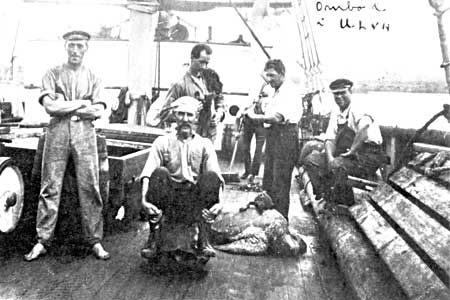
Finally at anchor in Academy Bay, Santa Cruz. For dinner: marine iguana and sea turtle. Steward Hjalmar Jensen is sitting on the next meal, a tortoise, to be sure it does not escape. The others are Kristian E. Stampa, R. Fogh, Alfred Andersen and C. Kristoffersen. Photo courtesy Arne Eilertsen.
Eilertsen returned with a bottle of brackish water for everyone to taste. He also reported that the island was not completely uninhabited as they had been told. Five Ecuadorians from San Cristóbal have been here for nearly one year, recultivating an old plantation in the highlands. They worked for Amador Baquerizo, who lived on the continent. They were to have been picked up long ago, and had no greater wish than to get away from the island.
Moreover, an old Mexican supposedly lived near the plantation. He had been there for 15 years, foraging exclusively off the land and from whatever an occasional fishing trip would provide.
Eilertsen thought it strange that nobody in Guayaquil or Wreck Bay had told them about these six people. However, the two officers who had travelled with them from Guayaquil said that this was no obstacle, and that the Norwegians should go ahead and settle wherever they wished.
The next day all went ashore to inspect the bays and its surroundings. The southern shore was steep and the cliffs were speckled white with guano. Pelicans and other seabirds crowded together on the ledges. Tall cacti stood like soldiers on guard along the entire length of the rocky promontory. By contrast, beyond the promontory and further to the south, there was a white sandy beach with numerous depressions. By flooding these man-made shallow basins with seawater, the local people produced crystalline salt crystals when the water evaporated. The bay was called Bahia Salinas or Salt Bay.
The north shore was more inviting, low lying and with a wavy coastline. Interspersed with jagged lava rocks were patches of white sand. Otherwise, the vegetation was much like that of Floreana. Narrow paths zig-zagged between spiny bushes and leafless Palo Santo trees. Some were goat trails, others were made by human feet. The spring of brackish water, not too far from a good landing place, excited the Norwegians. Another geographic feature of great attraction was a narrow bay leading toward the interior of the island. At high tide the motorboats could enter through a narrow passage and into a mangrove-fringed lagoon with white sandy bottom. This could become a splendid small boat harbor. Further inland still was an even more narrow channel where a small boat or canoe could pass through. On both sides were steep rock faces. Further inside this channel the rock wall was steep on both sides. Finally the channel ended in a small deep lagoon. Here it would be possible to corral whole schools of fish as well as to provide a shark-free swimming pool.
Altogether Academy Bay seemed to offer many promising prospects.
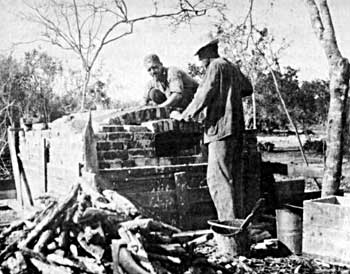
The same afternoon there was a meeting aboard ship to discuss the situation. It was decided that a more favorable site for a harbor and factory could hardly be found, but that in any case they should send a small expedition to every corner of the island in order to inspect the whole island.
A most important project for the first day ashore was the construction of a baking oven. Photo courtesy Thelma Lea.
On August 9th, both motorboats set out for Conway Bay located on the opposite side of the island. The white-colored smaller boat put Kaare Urholt and the old Mexican Latri ashore, returning the next day. Urholt wanted to cross the island and note everything of interest. The Mexican was to go along as pathfinder and resource person.
With Eilertsen, three other Norwegians and the two Ecuadorian officers aboard, the yellow-colored larger boat of 24 feet continued westward to Port Villamil on Isabela. The trip was intended mainly as a courtesy visit. It was important to greet the neighbors, even though they had to cross 60 nautical miles of sea to do so. The distance was comparable to that across Skagerak between Norway and Denmark.
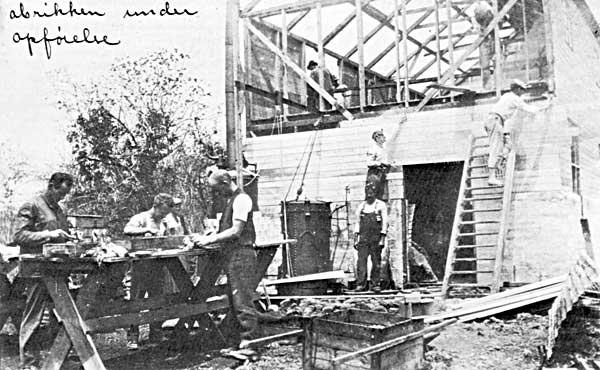
The large factory and seven small houses were prefabricated during the cruise aboard the Ulva. The construction progressed quickly and effectively under the direction of engineer Torstein Eig from Tønsberg and carpenter Henrik Furunes from Ekne. Photo courtesy Arne Eilertsen.
In Academy Bay the remaining expedition members start construction work on the dock, and clearing an area for everything that will be taken ashore. They decide to build the factory 40 meters from the dock; they also select suitable sites for the seven smaller houses. From the locals they borrow machetes, long knives that are easy to handle and readily cut through cactus, vines, bushes and small trees. The only large trees down by the coast are some old mangroves with thick twisted trunks.
Days of hard work follow; backs and limbs are stiff and sore when they rise in the morning. But this is the settler's life which they all have looked forward to—they really thrive.
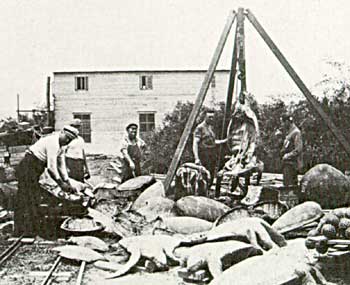
Great quantities of sea turtles were butchered and canned. Photo courtesy Arne Falk-Rönne.
One day three unknown peons or farm laborers appear. They are in a miserable state, but after something to drink they are able to relate that they are from Isabela, were out fishing in a canoe when they drifted off and landed on Santa Cruz. They knew about the brackish springs in Academy Bay and have walked along the coast for eight days before reaching the bay. Along the way they had to leave behind the father of one of the men when he was unable to walk any more.
The Norwegians take the son on a trip along the coast in the motorboat, but the old man was never seen again.
On August 20th, 11 days after he went ashore in Conway Bay, the Mexican Latri staggers into camp. His body is scratched and bloody, his clothes torn to shreds by thorns and sharp stones. He can only whisper: “Agua, agua – water, water.”
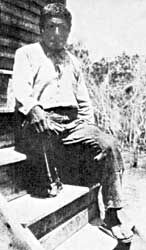
The Mexican, Latri, had lived a hermit's life in the highlands of Santa Cruz for 15 years. He showed the Norwegians how to make sandals using tortoise skin, and how to treat dysentery with hard-boiled eggs. But his knowledge of the region was limited, so otherwise he was of little help. Photo courtesy Karen Østmoen.
After quenching his thirst, he finally reacts to questions about Urholt and points out where he came from. Several men hurry along with bottles of water. Not far away they find Urholt staggering along in even poorer shape. Worst are his feet. The shoes are gone and the skin is cut and swollen. Many days pass before he can walk without pain. These two incidents are recorded by most of the men as examples of the survival of the fittest, nothing more, nothing less. It was foolish to rely on the Mexican to know the sources of water in the interior; here one must not take any chances and rely entirely on one's own resources and judgement.
Others feel ominously depressed. It is as if the island is trying to frighten them away at the very first opportunity! They have already been a hair's breadth from being shipwrecked, and now this. The sun-drenched paradise, where they are to live without a struggle or financial worries, now seems far removed from the unfriendly sun-scorched hell they have experienced up to the present.
Sleep comes late, even for worn-out bodies, when one worries about the future. There are many who lie staring into the darkness, passing a restless night as they think of their families back home, and feeling that they are in a strange and hostile country.
But whatever happens they are amongst fellow countrymen and friends—as long as they stick together.
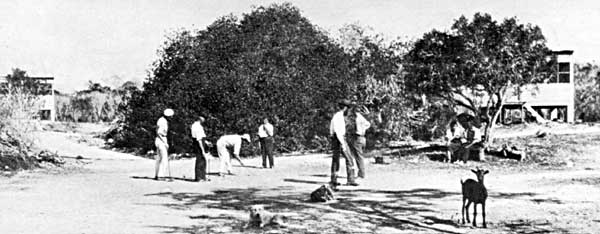
Sunday, playing croquet at “Ulvenæs Square.” Photo courtesy Arne Eilertsen.
The Sad Journey of Alatga
It is a beautiful mid-summer evening in 1985 at the farm of Råde near Steinkjer, in Central Norway. We sit in the garden in front of the main building. On the table made from an old mill stone there is a thick book labeled “My Diary 1926-39.”
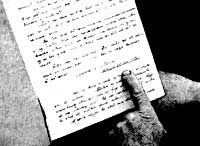
The dramatic voyage of the Alatga is described in the diary of Sigvart Tuset, now in the hands of his nephew Sigmund Tuset on the Råde farm near Steinkjer. Photo by the author.
Rough fingers carefully leaf through the pages, stopping briefly at faded photographs and postcards. A big paw is resting on the left knee. Hands and fingers are evidence of hard work on a farm where the livelihood is based on forest, field and stable. The farm is located a little bit north of the Fossum lake; we have a panoramic view across fertile fields and blue-green mountains. The fragrance of the lilac bush nearby is intermittently mixed with stable odors and the aroma of coffee from the kitchen directly behind us.
The man with the book is Sigmund Tuset. His father was named Jan and was the eldest of three brothers on this farm. The middle brother was named Sigvart. It is his diary that his nephew is leafing through attentively. Sigvart was born in 1898. When he left Norway, Sigmund was only two years old. He is not sure if he remembers his uncle.
The pages of the diary are neatly written in black ink, and with hardly any mistakes or changes. The author must have been an alert person, anxious to learn and to describe his experiences precisely and unemotionally. Sometimes he displays a dry wit but more often sadness seems to dominate his writings. More than once, Sigmund becomes bright-eyed and has difficulties in speaking—even though he has read the diary many times before.
The book is a story of urge to travel, of hope and ambitions, which the writer with some bitterness gradually realizes will not be fulfilled. It is also the story about the longing for family and homeland, and it is the story of the pride, which prevents him from returning before he can do so as a wealthy man, like a man who has “made it.”
Sigmund heard about my search for material on Galápagos-bound emigrants and sent a photocopy of the diary's first 253 pages. These pages covered three years exactly, from June 7, 1926 to June 7, 1929. This was as long as the dream about Galápagos lasted for the gardener Sigvart Tuset.
Sigmund leafs a little further through the book and reads from page 102, written in Panamá City, Thursday, January 13, 1927:
“Of the forty-two persons who travelled with Alatga from Tønsberg, four men decided to continue the journey to Galápagos. They were Bakke, Svendsen, Larssen and I.”
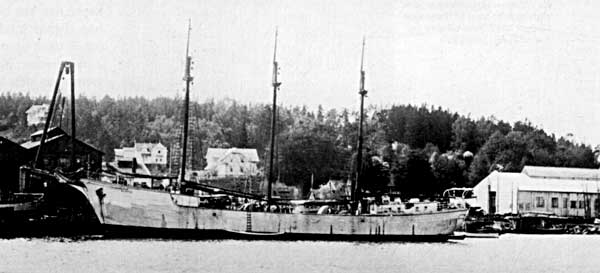
Alatga was a 43.8 meter (144 feet) long wooden motor schooner, 460 gross tons, built in Florida only seven years previously. She had two worn-out semi-diesel engines and her rigging was also in poor shape. The bottom was relatively flat, which made her a poor sailor and gave her the nickname “Aktafortvers” (“Backforthsideways”). The photo shows her under repair at the Kaldnes Shipyard in Tønsberg, Spring 1926. Photo courtesy Norwegian Maritime Museum, Oslo.
But during the previous half year, all sorts of things happened.
Alatga represented the other half of the Santa Cruz Company. In the Tønsberg News of July 8, 1926, the departure is covered in the following article:
Alatga departed for Galápagos yesterday.
Four of the members take their families along.
It created a big sensation in the port yesterday when a large Norwegian flag § waved from the top of the mizzen mast aboard Alatga, while the motor roared and belched dark clouds of smoke, and people could be seen very busy washing down the deck and checking the whole ship outside.
§ Author's Note: This is probably a printing error; it should be an Ecuadorian flag.
Soon, rumors surfaced that the reason for the sudden activity aboard the Galápagos traveler, which had laid idle at the Kaldnæs Mechanical Shipyard for such a long time, was that finally the departure, so often delayed, was scheduled yesterday afternoon for 5:30 p.m. and confirmed by Captain Alf Gude Due.
As the mid-day heat is setting in, we meet the captain while sitting on the cabin roof as he is enjoying a ‘Cromwell’; but he is very busy and therefore turns us over to one of his crew who serves as our guide. He is a strong, healthy and cheerful chap, who escorts us from fore to aft while he describes the ship and tells us stories. It is not easy to move about because both above and below deck all kinds of tools and materials for fishing, hunting, agriculture, and factory work are stored—and whatever else the expedition needs for work on Santa Cruz, the island on which the expedition has been granted a concession.
Under the foredeck is the crew's cabin with spaces for 8 persons, while most are housed in the cabin where a saloon is set up on each side. The ship's officers live aft, including the captain, first mate Wissing and second mate Schjelderup. Captain Gude Due is newly married and is accompanied by his wife and two children, thus combining a family expedition and a honeymoon. Wissing also has his wife and two children with him, and Schjelderup brings his wife and one child along. In addition, yet another member has his wife with him, and there is a woman member, Mrs. Maria Fleischer, who will serve as teacher and be in charge of the mess.
Our guide is very amiable, giving us a list of the members. But as he is enumerating, the captain hurries him along and says that he does not want the list of names published. Therefore we have to watch while the list of names is destroyed. Meanwhile, in return the captain kindly tells us that he estimates arrival in Panamá within seven weeks, and on the island of Santa Cruz within about two months. On an earlier occasion the captain was on the island loading guano and so he travels with great confidence, and such seemed to be the case with the other members of the expedition.§
§ Author's Note: Gude Due had probably never visited Galápagos. Guano in an amount sufficient for commercial exploitation has never been reported in Galápagos, but from several small near-shore islands off the coast of Perú.
“But are you not afraid of competition? Are there now not many who travel to Galápagos?”
“No, I have little confidence in the others.”
Does anyone doubt that all will work out according to plan when the captain is so self-assured? We wish them a good trip and jump ashore.”
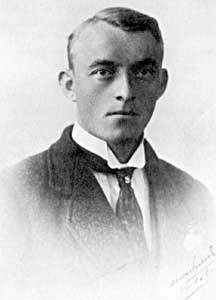
Sigvart Tuset was trained as a gardener but hoped to be a farmer in the highlands of Santa Cruz. He was one of the four from the Alatga expedition who finally arrived in Galápagos in January 1927. Photo courtesy Sigmund Tuset.
Details of how things went after the departure are told in Sigvart Tuset's diary. Problems plagued the flat-bottomed motor schooner from the very first hour:
“Tuesday June 8. Monday June 7 at 6 a.m. we left the dock at Tønsberg. There was universal rejoicing. We had the Ecuadorian flag up atop the stern mast. From the houses along the dock many bade us farewell with waving flags.
“The rejoicing, however, would not last long. Out in the fjord, while maneuvering to adjust the compasses, the motors stopped and we had to drop anchor. To-day around 10 o'clock we were able to weigh anchor and continue, but at mid-day they stopped again. The skipper is angry and tears at the few hairs that he has. The engineer says that the motors are no good and that they have no tools. The sails are now up but there is no wind and the schooner is drifting with the current. At the moment we are heading into the fjord instead of out of it.
“Friday June 11. Yesterday morning, half an hour before we finished watch, second mate Schjelderup sent me to the galley to brew some coffee before I was due to be off. As sick as I was I only managed to light the fire in the galley before I had to give up. This morning he got me up at three o'clock. I got the fire going and put the kettle on. Just as this was completed, the schooner suddenly lurched and I went backwards out the door with the kettle chasing me. Luckily, the water was not hot. I picked up the kettle and lid and was about to fill it with fresh water when, again, a new wave sent us rolling, with the result that I went head first through the other door. It was 4 a.m. by the time I had tied the kettle down and managed to light a new fire in the galley. So there was no coffee today either. For me it made no difference because I am unable to drink either coffee or water.”
The voyage from Tønsberg through the English Channel took 14 days; normally it should have taken only three to four days. It was impossible to make the two engines run for more than a few minutes at a time. Finally, the two engineers resigned and reminded the officers that in Tønsberg, before departing, they had pointed out a serious lack of tools and spare parts. It was a question of expenses of about 300 kroner. The captain had referred to the Ship Inspection which had scrutinized and approved both hull and engines. The parts needed were much cheaper in Panamá and would have to wait until their arrival there. Other expedition members who overheard the discussion believed that the engineers were uncooperative and sided with the captain. Had they not experienced enough delays already?
In the middle of the North Sea there were suggestions of heading the ship back home, but the three officers refused. The engines could be repaired in the Canary Islands. In spite of contrary winds and general despair, some were trying to be witty. The standing joke of the third mate was, “Mother's wooden mixing bowl was in poor shape, but racing in it I would have beaten Alatga.”
Sadly, this was close to the truth. Alatga was solidly built but flat-bottomed. The rig was old and half rotten and the sails became heavy as lead when it rained. On the whole she was a very poor sailer which rolled in the slightest sea. Sure, aboard were “fine young men with the best background,” as reported in the newspapers, but nevertheless in the North Sea they were very very sick, and the schooner got the name “Aktafortvers” (“Backwardsideways“).
Contrary to the other Galápagos expeditions, Alatga escapes the compulsory gale in the Bay of Biscay. Slowly and with light winds she rolls towards Las Palmas. Sigvart Tuset begins to report for his graveyard shift (midnight to 4 a.m.). The worst aspect of this shift is trying to sleep when others are noisy with their breakfast. But he discovers that one can become accustomed even to that.
After a record-slow sail of 34 days, they drop anchor at Las Palmas, Canary Islands, on July 11. For most of those aboard this is their first encounter with a foreign language and culture. Tuset describes his fascination with the horse-drawn taxies along the waterfront, the women who carry heavy loads on their heads, and ends that he is in fact getting something in return for his share money. The manner in which a man courts his sweetheart through barred windows he also finds fascinating. The women's mother or grandmother is the chaperon and never far away.
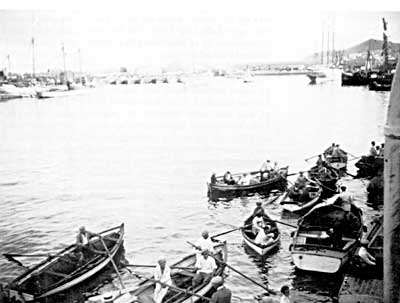
In the harbor there is considerable traffic, including Norwegian ships which stop mainly to refuel. A Norwegian who runs a ship's chandlerey helps them to get the engines repaired. They also take on diesel oil, which proves to be far too thick and useless, and is later sold in Panamá.
Alatga arrived at Las Palmas, Canary Islands after a sail of 34 days. The port is teeming with activity. Winter clothing is exchanged for vino, fruit and souvenirs. Photo courtesy Robert Ødegård.
The last of the expedition members' winter clothing is bartered off in La Palmas. For most of them their money is all gone but optimism is at an all time high.
“Saturday July 17. Today I bought a revolver for 10 dollars from Eggen, and now have 2 dollars left until we arrive in Panamá. We are not sure that we can go ashore there, and in Galápagos we do not need money!“
After ten days they set out into the Atlantic proper. Because of all their delays they must pass through the tradewind belt to the West Indies during the months of July/August, at a time when the winds are the least stable, the weather the warmest, and the threat of a hurricane the greatest. But for now they are lucky and have mostly fine, calm weather. Thus they experience the bewitching nights when the winds are balmy, and the stars twinkle, and the Earth's problems seem unreal and far removed from their small isolated world aboard Alatga. Between the Canary Islands and the West Indies they do not see a single lantern or other sign of civilization. Faithful friendly followers are the storm petrels that fly with beak and toes touching the tips of the waves, tirelessly hunting for scraps of food. They see other seabirds from time to time. And especially during the night they hear the porpoise's high pitched whistles and splashing when they jump. Daily, schools of flying fish rise and glide in fan-shaped formations to either side of the bow.
In the early hours of Wednesday August 18 they approach the West Indian islands. The first sighting of land on the American continent comes slightly unexpectedly:
“At 2:30 a.m. after the moon had set, we saw low land directly ahead. This situation demanded immediate action. We cried out, ‘all men on deck!’, got the mizzen reefed, put the helm down and brought her about so that we were tacking in the opposite direction. Just as we altered course we had a rock, only a small schooner length off port side. This night is the only time that the wellbeing of the ship and ourselves are at stake. Half a minute's delay and we would probably have touched land.”
It is the British colony of Antigua that nearly put an end to this adventurous voyage. The next day they anchor at Christianstad on St. Croix, i.e. Santa Cruz. There are many who wish they were anchored at another island with the same name much further west.
The old Danish-Norwegian colony is now a part of the American Virgin Islands, but the governor who comes to greet them in a motorboat is still Danish. He offers assistance in case they need anything.
In the Canary Islands an attempt was made to repair the engines, but as usual they refused to run after some hours. Nevertheless, Gude Due graciously declines the offer of help saying that they will make the repairs themselves. The governor has to inform them that no one may come ashore without a visa and a medical examination, just as in any other American port.
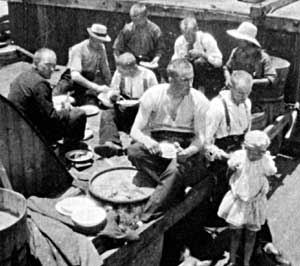
So they continue on their journey the next morning without doing anything with the engines and without being ashore in “the American Paradise.” Nearer Panamá there is more rainy weather and less wind. The final stretch to Cristóbal goes rather poorly. The food now consists almost entirely of salt meat and canned foods.
Lack of fresh food was the greatest problem for the colonists on Alatga. It was tolerable as long as the sailing was good and the trade winds friendly, but it became worse after Panamá. Several suffered from weakness and lethargy, an early sign of scurvy. Photo courtesy Sigmund Tuset.
The flour supply is diminishing, and breadless days are introduced in order to make the provisions last. Beneath deck it is getting damp and most of the potatoes have to be thrown overboard. Only rarely do they catch fish. Repeated attempts to harpoon dolphins fail, but a shark measuring one and a half meters is relished like a real delicacy. As a rule, however, the food tastes miserably, not only because they lack fruit, vegetables, flour and grain, but also because there is no experienced steward aboard—only an inexperienced cook with the nickname “Kleitick.”
But most of the criticism is directed at Maria Fleischer who has the thankless job of serving the officers. Often she is reprimanded by the captain in the presence of others.
But they try to maintain their humor. During the long night watches westward in the Carribean Sea, the schooner's own chanty is composed by Per Rotnes. Some days before they reach Panamá, a ship's orchestra gives the first performance on the foredeck. The orchestra is a quintet consisting of an accordian, mandolin, mouth organ, comb and tin saucepans.
ALATGA'S SONG
Anyone wanting a trip on a ship
Do go on Alatga for one little trip
For month after month all you see is the sea
From wages and fun you are constantly free!
If Norway you leave in late May or June
Dover by Christmas—consider it soon!
Journeys will end even when they go far
And Alatga, a ship, looks more like a tramcar!
But it could have been worse by thrice,
If in Las Palmas we all caught the lice!
Many cheered and ate and spent every penny
And decided that our “Kleitik” was one “cook” too many!
To be perfect in cooking and messing,
Maria will teach it with glorious blessing.
She instructs her troop of dirty chaps
In foodmaking based on morsels and scraps.
Maria: to get into a man's heart
You must with his stomach lovingly start!
One night asleep and with nothing feared,
A shadow ahead with haste appeared.
Bodies at rest jumped to their feet,
Quickly there wasn't a person asleep.
We cried “land ahead” and rang the bell,
The skipper so scared, didn't even shout “hell.”
Then to the island with the holy name,
Ashame! Though the name be the same
We must still go on for thousands of miles
Trying to do so with bravest of smiles.
Alatga she rolls from one coast to another
One day we'll arrive, supposing we bother!
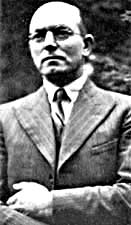
Peder Fremstad from Gjøvik was an agriculturist, but he had to serve as cook about Alatga, even though he had no experience in the preparation of food. He was one of those who never reached Galápagos. Photo courtesy Haldis Fremstad.
Alatga arrives in Cristóbal on September 1. Not until September 27 does she head for Panamá City on the opposite side of the narrow isthmus between the Caribbean Sea and the Pacific Ocean. By then the expedition has experienced one disappointment and adversity after another. Three shareholders have had enough of it and have left the ship.
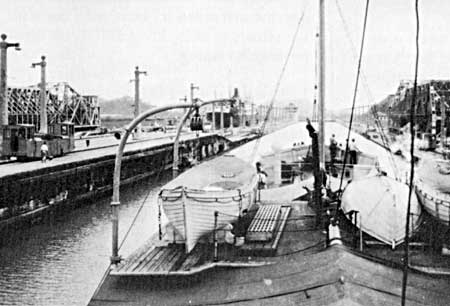
The Panamá Canal was an engineering marvel, a symbol of America's ability to look to the future. Even at the 1914 inauguration, electric-powered trains were used to keep ships steady when the gates were opened or closed. While Albemarle passes through the Canal in October, Alatga fights for her survival only a few hundred miles farther south in the Gulf of Panamá. Photo courtesy Robert Ødegård.
The first shock comes when they discover that there is no money from the office in Tønsberg, and they are also confronted with Ulva's debts. Eilertsen and Co. had borrowed money from a shipsbroker at Colón in order to be able to bunker and pay for the pilot and canal expenses. Since Alatga belongs to the same shipping company, she was refused passage until all payments for Ulva as well as her own expenses are placed on the table.
The ship's coffer is scraped clean to the bottom. Rumors about the company's poor financial status spread quickly, and even a loan for the purchase of provisions is denied. Most of the expedition members on board are also without money and cannot provide food for themselves either.
Soon everybody in the port has heard about their distress. Some Norwegian ships passing by invite a few for dinner or offer some leftovers. A missionary society and another Christian association also help—first the women and children. They invite them to meetings and present them with some flour and preserves.
Tuset finds it very embarassing to have reached a state where he has to live off charity. He never imagined himself in such a situation. He feels like a hypocrite when he attends the Christian meetings where only English is spoken and he understands little or nothing about the preachings of the gospel—just to get a free cup of coffee and some pieces of cake.
The weather in the Canal Zone is, as usual, warm and humid. Nevertheless, the rain is welcome because they obtain clean drinking water. But since they lack any effective means of catching water in large quantities, there is still insufficient amounts in the tanks.
Telegrams pass back and forth to Tønsberg, mostly on the consulate's account. Hyenæs at first refuses to send money and says they have to arrange a loan themselves, using the schooner or her cargo as security. After repeated demands, enough money finally arrives to cover the most essential expenses and to have one of the engines repaired.
Men from a mechanical workshop are summoned, but when they arrive the captain himself hands over the damaged parts without the presence of the ship's engineers. The instructions he gives prove to be incorrect. The parts are returned, repaired as requested, but they do not function, and need still more attention! More delay and more expenses.
The first to leave the ship is Maria Fleischer. She has been the brunt of more insults than she can endure. First mate Wissing and second mate Schjelderup also take permanent leave of the ship with their families. They both find adequate salaries on farms in the Canal Zone, but have to forfeit their shares in the expedition, as does Mrs. Fleischer. Together with Gude Due the two mates were prime movers of Alatga's part of the Santa Cruz Company. They do not part without exchanging insults. The captain has to listen to accusations of irresponsible planning and exploitation of innocent people's money.
In the evening of Monday September 27, Alatga begins the last stretch to Galápagos. “…all appeared to be going well, both motors were running and the schooner moved with good speed according to plans. But here, as near Tønsberg, this pleasant state would not last long. During the night the motors stopped and we were becalmed and drifting worse than on the first occasion. We are finally in the Pacific. To-day, Friday, we still see the wooded hills above Panamá. In other words, the whole situation looks rather ridiculous, but we are not in a frame of mind for laughing.”
Sunday October 3: The sight of land finally disappears behind, but the ship advances unbelievably slowly. The engines work on and off but the engineer has given up for the present. Several aboard are suffering from vomiting and diarrhea. The cause is connected with another effort at saving money. While sailing through the canal they filled the water tanks directly from the Gatun lake. The water both smells and tastes of decaying plants.
Provisioning in Panamá City they only had enough money to buy potatoes. Because of the high humidity below deck, some of the potatoes are already spoiling and have to be thrown overboard. The flour is riddled with maggots. Even “knallen,” the ship's biscuits or cabin bread, are alive with beetles. They are now living mainly on salted meat and dried fish brought from Norway. According to Tuset a rotten smell pervades the whole deck when dinner is prepared.
In a series of gales during the next two days, most of the rigging is torn to shreds. First the stay and mizzen sails are blown to rags, then the peak halyard parts causing the gaff to fall down, tearing the mainsail. At the same time it rains buckets, making it impossible to repair the heavy rags.
It is now decided that they must return to Panamá as soon as temporary repairs will allow. Captain Gude Due agrees to this only after everybody aboard had signed a declaration stating that he is not to be blamed for not continuing to Galápagos.
Because of overcast skies up to now, they have calculated their position by dead reckoning. At the first appearance of sun, the sextant observations reveal that they are well south of Panamá City. For two days they had sailed in the wrong direction! This delay proves to be disastrous.
With the return of gale force winds and thunderstorms during early hours of October 12, the patched-up staysail and mainsail parted again. One of the engines has worked irregularly for a few days, but now one cylinder cracks and a bearing gives out and this engine also stops for good.
“Wind and current headed us straight for land and it seemed impossible to avoid becoming shipwrecked. The night was pitch dark and it rained as if the skies had opened up.
“We feared that something would happen and in spite of the pouring rain, everybody ventured out on deck, listening for breakers against the ashore. The waves increased as we approached land.
“When I went below at 2 p.m. for some sleep, all the crew were on deck and it was easy to see that we moved quickly towards land. The foresails and mizzen were still up, but the mizzen sail was soon torn and had to be lowered; next the foresail had to be reefed and the schooner was left entirely to wind and current which took her directly towards shore. I could not sleep after all. Reflected waves from the shore became noticeable, and the watch started to take soundings but did not reach bottom with a line of 20 fathoms.
“We were told to get ready to leave ship at short notice. Shortly after the order was given to drop anchor to see if it would touch bottom; the anchor chain being 60 fathoms long.
“We felt incredibly relieved when the anchor held at 15 fathoms. It was still too dark to judge the distance from shore; but later it was discovered that we were anchored about 200 meters outside a steep, rocky headland.”
For eleven days Alatga remains at anchor in a gale 200 meters off a lee shore and certain disaster, near the border between Panamá and and Colómbia. The land beyond the rocky slope is a jungle, dense like a green wall.
That they escape from here safely is almost unbelievable, but the chain and anchors must have been about the only items aboard that were of top quality. The other anchor has also been lowered and has a firm grip on the bottom.
The anchors hold even when the winds are howling and the bow gets buried under the sea to the extent that at times it is dangerous to move about on the foredeck.
While the gale is raging and the ship is pitching like a bucking bronco, conditions aboard are truly hellish. One can do nothing but sit with one's trunks and knapsacks, helpless and frightened, hold on tightly and pray that the chains don't break.
Finally the weather improves sufficiently to permit rowing ashore to explore, gather firewood and search for food and signs of civilization. They do not see any people, but find two vacant Native American huts, and they return with some most welcome lemons, coconuts and bananas.
During one of these trips ashore the rowboat capsizes in the surf. Besides the firewood they had gathered, they lose pants and shoes that were placed on top of the load. The boat is damaged and is hoisted onto the deck of Alatga for repairs. But they have, yet again, been spared personal injuries.
By Saturday October 23, the wind has calmed down. The sails are patched as best can be done, and the engineers have performed a small miracle. They think that it is possible to run one of the engines for a few hours—at least until they are out of danger.
In Tuset's cabin the men do not have much faith in this statement. No one is willing to bet five kroner (US $1.00) that they can stear clear of land from their deep cove, with headlands on each side. Everyone has packed as much of their personal effects as possible and are ready to jump ashore in case they go aground.
“Saturday morning we weighed anchor. The engine actually ran long enough to turn the schooner out from land, before stopping for the last time. Several times it looked as if we could not escape the shore, but the current helped us out each time. When we passed the headland which we most feared, we saw a pair of pants and a shoe ashore—reminders of the firewood expedition.”
A sou'wester breeze gives them a favorable passage to the north, and two days later they approach Panamá City. Then the wind slackens, the current carries them away from the town and they have to drop anchor to avoid running aground on one of the shallow banks off the Pearl Islands. Days follow with lowering and weighing anchor and drifting with the current in order to get nearer their goal. In between they make trips ashore to some of the uninhabited small islands nearby and gradually realize that they are really out of danger.
Finally on November 1, they get so far that they can drop anchor outside Panamá City after a “roundabout trip in the Pacific that lasted exactly five weeks. And it can truly be said that this has been a bothersome trip.”
But nearly three more months pass in Panamá before the fate of Alatga and the expedition members is finally sealed. All attempts to obtain money for the necessary repairs fail. Moreover, there are now so many rumors about Galápagos circulating that most of the expedition members say they are happy they did not land there after all.
In a letter from consul Bryhn they learn that Ulva is back in Guayaquil and up for sale. They write back requesting Ulva to take them to Galápagos. But even after reminders, they receive no reply.
Meanwhile, equipment aboard Alatga has to be sold to raise cash. Finally, a buyer offers 10,000 dollars for the ship. After all debts are paid and some of the members have left the company (and thereby renounced all claims), there are 150 dollars for each person.
Only Tuset, Svendsen, Bakke and Larssen decide to stick to the original plan and see with their own eyes what Galápagos really has to offer. Most of the other expedition members spread out across Central and South America, while some return to Norway. For a short time, Gude Due gets a job as skipper with a tugboat company in Panamá before he leaves for the United States and finally for Oslo.
Tuset and his comrades travel aboard the cargo steamer Alkamar from Amsterdam down the coast to Guayaquil. There they encounter other Galapágos-Norwegians from different expeditions.
From the Christensen expedition they meet a most resigned Axel Seeberg who relates that of the original colonists fom Sandefjord only Morten Wegger and Oscar Kjøle are still on Floreana. The whaling venture has met with endless obstructions and bad luck and is still not underway. It is true that Isabela finally arrived but Seeberg doubts that this will make much difference. Presumably Seeberg is travelling back and forth trying to get consul Bryhn to pull some diplomatic strings.
They also meet several men from Albemarle, another Norwegian-Galápagos expedition. This one is led by Harry Randall and has arrived earlier, even though it left Norway long after Alatga. These men are on their way to Perú looking for jobs in the mines. They are in a hurry to get away from both Randall and Galápagos and keep referring to cheating and tales of fantasy that have nothing to do with reality.
“The islands are dry as heeps of ash and suited only for iguanas, sharks and a handful of niggers!”
Fortunately, Tuset and his group also encounter the representatives of La Compania de Santa Cruz. They have arrived on the continent to arrange the company's business affairs. Tuset is impressed when he learns about what has been accomplished on the island. The factory and seven houses have been constructed, a channel leading to the lagoon has been dynamited, a pier has been built and steel rails have been laid from the pier to the factory. Canned food has been produced only two months after the Ulva first dropped anchor in Academy Bay. The quality was excellent and the trial sales of the test batches have so far been promising. Regarding farming in the interior of the island, he learns that radishes almost shoot up through the soil and are of a fine eating quality after a couple of weeks. Many other plants have also been found to grow in record time.
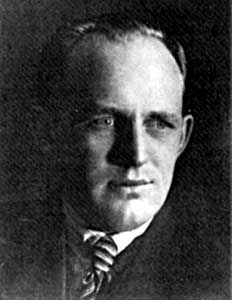
This sounds promising, for farming is Tuset's main interest, and he is now looking forward to getting going. Otherwise, Tuset does not get a favorable impression of the company's trusted men, except for the head man. The others have drunk too much liquor, and that, he reflects in his diary, always makes a bad impression.
Agriculturist Karl Wisløff from Oslo planned a lasting future on Santa Cruz. But when Alatga was finally sold in Panamá, he braved the fear of “The Norwegian Snear” and used his $150 share of the sale to travel home at the first opportunity. Photo courtesy Karl Wisløff, Jr.
Isabela is anchored in the harbor. The small sloop arrived too late in Floreana to save the colony there, and now she is navigating between Santa Cruz and Guayaquil, a trip of five or six days each way.
Isabela is due to leave leave for Santa Cruz the next day. After some negotiation, Tuset and his three friends are permitted to come along. Tuset writes in his diary:
“During the passage to Santa Cruz the weather was pleasant but it was not a comfortable voyage aboard the little sloop. The cabin was jammed with cases and sacks, so we had to stay on deck day and night. There was hardly space to move. To go to sea in such a small vessel is truly a Viking feat.”
About the skipper, Paul Bruun, he writes that he is a tall, strong man, 54 years of age. He gives the impression of having inexhaustable energy and humor. It seems like he does not need any sleep at all.
“Aboard Isabela he is captain, mate, engineer, able-bodied sailor, cook and the best entertainer one could ever meet.”
Some days later, the four men from Alatga join the other colonists on Santa Cruz.
Randall's Galápagos Expedition
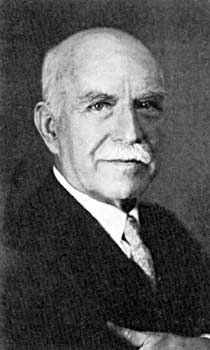
Harry Randall's expedition to Galápagos was the biggest of all. When the ship Albemarle left Oslo on September 2, 1926, there were 83 people aboard, counting young and old. Of these, five were hired as ship's crew and were neither partners nor had plans to settle on the islands.
Harry Randall's surname was originally Petersen. He was trained as a first mate, but assumed a new name and new profession in the United States. Back in Christiania, from 1908 he was an amusement park director, artists' impresariso, and editor. Randall wrote a book which contributed very much to interest in Galápagos, and he was also the instigator of the biggest expedition. Photo courtesy Sylvia Randall Andersen.
With so many Norwegians interested in emigrating to Galápagos, Randall could have done like Christensen, Eilertsen and Gude Due and picked professional seamen from among the applicants. Randall's original plan, however, was to put the ship on a regular route not only between Galápagos and the Ecuadorian mainland, but also between Galápagos and Norway! For this he needed a steady crew. Others aboard would not receive a salary, although agreeing to do various jobs on a rotational basis. In this regard Randall's plan was somewhat more realistic than was the case with other expeditions.
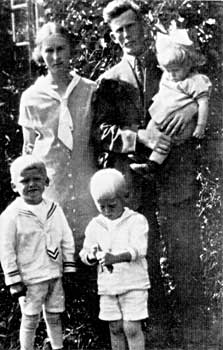
Of the 78 members, not counting the crew, 55 were paying partners and 22 were family members. As organizer and leader, Harry Randall received a free berth and a free share in the expedition's properties. The 55 were divided into 51 men and 4 women, each of whom paid kr. 3,000 each.
Farmer Haakon Glemmestad from East Toten was among those planning to have his family join him as soon as the colony was established. He soon traveled to Ecuador with Nils Einstad to look for better opportunities than on San Cristóbal. The two disappeared. Those back home got the help of relatives in the United States to initiate an investigation. Many months later it was discovered that Glemmestad and Einstad died in Colombia about June 17, 1927. They had been robbed of everything. It is not known if they died of tropical diseases, or if they were murdered. Photo courtesy Glemmestad family.
Forty-two travelled alone, some because they were single, while others had left their family at home, planning to bring them across when the colony was established. Twelve men were accompanied by their wives. Karl Aune was accompanied by both his wife Ragna and his 73-year old mother, Kirsten Aune. For each of these 500 kroner had to be paid to the company. The carpenter Karl Pettersen was a widower and brought his sons Leif and Rolf aged six and eleven years. The farmer Thorleiv Guldberg was also a widower and was accompanied by his three children Karin, Snefrid and Frithjof, but since the youngest was nearly 18 years old, all these were regarded adults and had to pay 3,000 kroner each. In addition to the two Pettersen boys, there were seven children younger than twelve years with the expedition. The price for each child was 250 kroner.
As with Floreana, Ulva and Alatga, Albemarle was much delayed in getting on her way. The initial departure date of July 15 for Randall's expedition was a date only three months after the plans were first announced! At that time he had no ship, but first wanted to “test the market” and, depending upon the response, look for a vessel of suitable size.
The first meeting of interested expedition members was at Randall's home in Oslo on May 9. Twenty-two men agreed to pay an advance of kr. 1,000 to an account at the Fellesbank, and thus the expedition was a reality. But only at the constitutional general assembly on June 1—with 38 persons present— are committees selected to purchase a ship and ship's stores, fishing gear, construction materials, provisions, tools, etc. Even with no ship at hand, they stick to the same departure date, though this is only six weeks into the future.
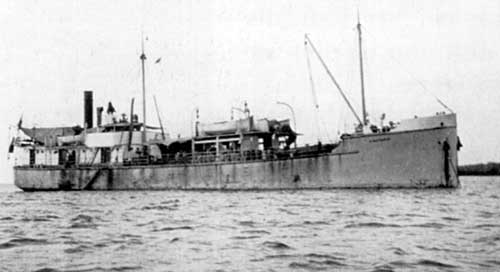
They soon realize that the ship will be the biggest problem.
Albemarle was built of ferro-concrete at Greaaker Ferro-Cement Shipyard at Moss in 1919, and was originally named Concrete. In Lloyds' Register she was listed at 728 tons, whereas in Randall's advertisement she was stated to be 1000 tons. Her length was 51.5 meters (172 feet). Photo courtesy Sylvia Randall Andersen.
The ship's committee, consisting of engineer Hugo Stray, and mates Gunnar Andersen and Hans Bjørnsted, have distressingly little time to prepare. They have agreed to purchase Concrete from the Arthur Mathiesen Shipping Company by June 20. The large 1,000 ton ship was built in 1919 from ferro-cement at Greaaker Ferro-concrete Shipyard in Moss. The ship has no sail but twin 91 HP Bolinder diesel engines.
The motors are in poor shape, but according to the contract with Mathiesen, it is his responsibility to have them repaired at the Moss Shipyard before the trial run and delivery in early July.
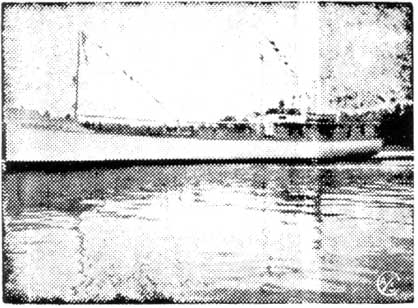
Randall's Galapagos Expedition
which leaves via Panamá for the Galápagos Islands on July 20th this year with this first class ship, 1000 tons dead weight, and pictured here, can still receive a few participants. The expedition is financed through charges of kr. 3000 per person,§ and this money is administered collectively through committees chosen at a General Assembly, and will be used to purchase building materials, provisions, tools, boats, fishing nets, etc. In this way everything is to the benefit of individual members. The money may be forwarded to Fellesbanken Ltd., Oslo.
§ US $1.00 was the equivalent of approximately Kr. 6 in 1991.
This invitation to Harry Randall's expedition was published in newspapers throughout the country. The one shown here appeared in Gudbrandsdølen on Saturday, July 3, 1926. Because of possible prejudices against concrete, no mention is made in the advertisement of the material used in the construction of the Albemarle hull.
The work at Moss does not proceed as promised. One excuse after another is given for the delay. Not until July 27 does the boat have a trial run. The speed is miserable and soon one engine stops. Albemarle,§ as she is now named, is towed to Oslo so that expedition members can themselves make repairs. At the same time they can start building a new superstructure above the main hold. Here they install berths and ventilators and can start loading provisions and personal property from the warehouse in Vippetangen, Oslo.
§ The old English name for Isabela, the largest Galápagos island.
While dismantling the engines, they discover that a starboard cylinder is misplaced in a port engine with the result that the greasing channel became blocked and the bearings burnt out. Other deficiencies in the work done at Moss are also pointed out.
The agents from the Coast Guard come aboard and give a series of costly directives. Concrete was registered as a barge, while Albemarle is regarded as a passenger ship. Four new lifeboats must be mounted on davits and 70 new cork life-preservers and four life buoys must be provided. The money flows like a falling tide from the “Galápagos account.”
Next, officials from the police and Social Welfare Department come to determine that emigration laws are obeyed down to the last detail. Several problems come to light. Randall is not an approved agent and no guarantees or funds are provided if problems arise during the voyage. The previous expeditions were spared these thorough investigations, but now the Foreign Office has received warnings from consul Bryhn in Ecuador about problems with all earlier expeditions.
The newspapers eagerly catch on to the topic—perhaps the entire venture will end in a scandal? Harry Randall's name is well known in the capital, and especially at the popular Theatre Café his problematic expedition is a favorite topic of conversation. What kind of adventure has Randall now become involved in? What are the man's qualifications as leader of an expedition? Who, indeed, is this Harry Randall?
He was born in Christiania in 1858. Johan F. Petersen his father was a lawyer and “chief debt collector” of Akers Savings Bank. The son took on the name of Randall when he settled in the USA in the late 1880s.
Harry received his education from Christiania Middle School and Christiania Navigation School. As an officer, he saw much of the world, but when he moved to the USA he broke with his maritime profession. He became a theatre director and impresario for traveling artists and lecturers, including Roald Amundsen after his successful voyage with Gjøa through the Northwest Passage. For a while he was also director of a cigar factory and later of a Scandinavian import business in New York.
By 1908 Randall was back in Christiania. Here he became director of the Tivoli, continued with impresario activities, arranged concerts and travels, and for some time managed a cabaret theatre. Then he became publisher of the monthly magazine Overalt (Everywhere), and also for four years Norsk Sjømands Magasin (Norwegian Seamen's Magazine).
Harry Randall was known as a gifted orator, an able master of ceremonies and an entertaining storyteller. And he was a talented accordionist.
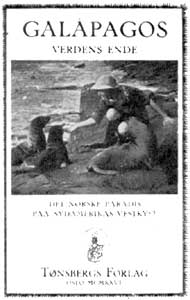
Galápagos had fascinated Randall for a long time. He had met the three Norwegians who were on Floreana in 1922 and he was interested in the writings about Christensen's expedition. It was he who took the initiative of publishing a small book in the Spring of 1926: “Galápagos—World's End“, and with the sensational sub-title, “The Norwegian paradise on South America's west coast!”§
§ Galápagos—Verdens Ende: Det Norske Paradis Paa Sydamerikas Vestkyst, Tønsbergs Forlag, Oslo, 1926.
This small book was published in the Spring of 1926 and described a rosy picture of Galápagos as “the land of future possibilities.” The authors were Harry Randall, Finn Støren, Per Bang and Aug. F. Christensen. The title and cover picture were borrowed from William Beebe's famous—and romantic—book about the archipelago, Galápagos: World's End.
The book contained three chapters. The first and longest was written by Randall himself and was called “Galápagos Islands at the time of pirates, whalers and penal colonies.” Chapter two was written by Finn Støren and Per Bang, entitled “Two Norwegians' adventures on Galápagos.” The third chapter was titled “The first Norwegian colony on Galápagos” and was naturally written by consul Aug. F. Christensen.
The book became a bestseller and contributed significantly to spreading the Galápagos fever in Norway.
At about the same time that the book was published, Randall profitted handsomly from the sale of shares. When he heard about the immense interest in Eilertsen's venture in Larvik, he decided to organize his own expedition. He was then 68 years old but unusually fit for his age.
Meanwhile, Albemarle still lies at Vippetangen in Oslo harbor, while the days and the cash disappear at an alarmingly fast pace. Emigration officers accept a guarantee of kr. 7,000—put up by Randall personally—and generally turn a blind eye to some less important shortcomings.
Finally, the authorities insist that the ship must have a responsible owner, and a shareholder company is established. Now the financial condition is so bad that they have to look for kr. 15,000—for fuel and cash expenses during the voyage to Galápagos. Ten partners, who are willing to provide more money for the company, become shareholders, with the ship as security. Hugo Stray, a mechanical engineer from Oslo, is the leader for the time being and now the official ship's owner. The other shareholders are mates Gunnar Andersen and Hans Bjørnstad, carpenter Karl Pettersen, merchant Molvin Knutsen, donkey-man § Jens Sæther, farmer Peter Vasgaard, foreman Alf Ødegaard, laborer Emil Larsen, and secretary Snefrid Guldberg.
§ A person who operates a small steam engine (donkey engine).
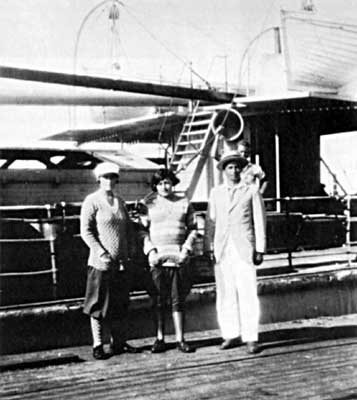
Finally it looks like departments, offices and head officials of Oslo will release the expedition. Now it is important to get going before additional complications arise. In spite of all the gloomy predictions, especially in Arbeiderbladet (The Workers' News), the ship leaves the dock with a course set for the Pacific.
Guldberg siblings in front of Albemarle before departure from Vippetangen Quay, Oslo. Frithjof is already dressed for the tropics, and is probably peeved about the arrival of autumn before he can leave. Snefrid to the left, Karin in the middle. Photo courtesy Hage family.
Harry Randall kept a diary during the voyage.
“Thursday, September 2nd, 6.15 a.m. we left Oslo. Spent two hours on the Bundefjord where a man from the Navigation School adjusted our compasses. It cost us kr. 125—which the Norwegian government charges for these few hours of work by one man. When once again we entered port, we had a collision with a sailboat whose two drunken chaps sailed right into us. If there had been an accident in which one of the two had fallen overboard and drowned, I can imagine the scandal that the Randall expedition would have experienced, and especially in the Arbeiderbladet, which would have gone on about my lack of ability as an expedition leader.
“Luckily, all went well, but two minutes later, the same sailboat with the two drunken men nearly had another collision with a nearby motorboat.
“Then we set the course southward and arrived at Fagerstrand at 11 o'clock where we stayed overnight and loaded 40 tons of fuel. At 3 o'clock near Færder the pilot left us and a southward course was fixed. The weather was marvellous with bright sunshine and glittering sea, and all aboard were happy to have escaped from all the “friendly” authorities in Oslo, the various departments, coast guard, police and consulates, which never ceased to scrutinize the expedition.
“The port authorities did, however, show extraordinary goodwill by not charging port and docking fees, which amounted to more than 700 kroner.
“Likewise, at the last moment—on orders from the coast guard, the town physician, Bentsen, was sent aboard to examine each of the expedition members, and when he learned of their weak financial status he did not charge a penny for himself.”
Elementary school teacher Einar Austlid also kept a diary. He was one of the many single men aboard who experienced the voyage and the happenings on the trip from the bachelor's section of the cabin. The diaries of Randall and Austlid describe very different aspects of life aboard ship and ashore, and complement each other splendidly. The following is a summary of the first days of the voyage, as Einar Austlid experienced them:
“September 2: Finally, Albemarle weighs anchor. We can hardly believe it. The dock is crowded with people, friends and family, the curious and the idle on-lookers. Packages and flowers shower the ship. Shouts and laughter, good wishes and facetious remarks are heard. There is waving of handkerchiefs and hats, and farewell calls as long as we can be seen from land. Nobody cries, and hardly a tear. We are outward bound. We feel like a load has been lifted off us as the rhythmic vibrations of the engines increase and the ship is on her way. Yes, now we are traveling in earnest toward foreign shores.
“It is evening and dark. The lanterns throw bright, shimmery strips of light over the fjord. Waves splash against the sides of the hull. The skies are strewn with stars. Only the noise of the engines interrupts the stillness of the night and a strange mood is upon us. We stand at the railing and stare into the night. Shall we really leave old Norway in earnest and settle on unknown islands far out in the Pacific? There is no doubt. The engines pound and spin, and the sea lies endlessly in front of us.
“I am tired and go to bed. The hold is divided lengthwise into two equal-sized rooms, one for single men, the other for couples and children.
“I belong in the bachelors' room. The berths are arranged in two tiers along the walls. Here they play cards, accordion, violin, guitar, or sing and howl a roaring noise. Perhaps they wish to drown out heavy thoughts and yearnings, who knows?
“I lie down and doze. A child's cry can be heard through the wall. ‘Good heavens, so snug and homey,’ says a six-foot six tall chap from Ålesund who is married and has a photo of his wife on his berth wall. But the person in the picture is not along.
“September 3: Clear weather and fresh wind. Still in Oslofjord, and there, far ahead Færder lighthouse. A white pilot ship in full sail is approaching us. The pilot stands broad and secure on the bridge. Soon he will go ashore. He boards the sloop which soon disappears from view. The pilot carries letters to our loved ones, our last greeting home.
“September 5: Sunday morning. I awake with calls from deck: ‘Ahoy, mackerel!’ Some of the fellows roll out of their berths and hurry on deck. Yes, they really catch mackerel! Mackerel for breakfast. Sunday passes as usual, only that we do nothing. After coffee we carry the gramophone on deck, sit around it, listen to music, smoke and joke. And the ship makes her way slowly but safely.
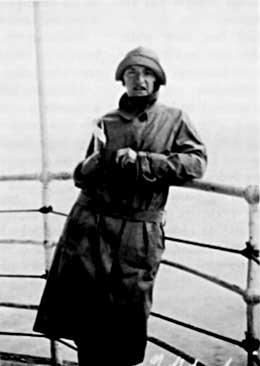
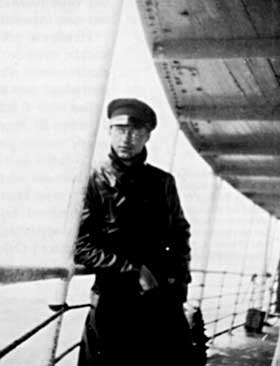
Ruth and Alf Ødegård on a rainy day while underway on the North Sea. Ødegård was from Oslo and attended the Railway School when a boiler exploded. As a result, his eyesight was damaged and his career as a locomotive engineer ruined. So he decided to emigrate with his wife. Photo courtesy Robert Ødegård.
“One of the committee members is furious concerning comments about us in some newspapers before we left; he swears that we must have a betrayer amongst us. ‘When we arrive at the Canary Islands, there will be a letter awaiting for me,’ he shouts, ‘and then I'll know who the scoundrel is and teach him a lesson.’
“My nearest bunk mate is a cheeky and foul-mouthed chap. Fat like a pig, but he is a poor soul at sea. Today he sacrificed to the crabs. Gad, what an ugly sight! And later, not a word. Several times earlier, I felt like shoving my fist into his mouth. But now I am sorry for the poor fellow, pale and suffering as he stands at the railing and vomits.
“We miss the newspapers and I am thinking about editing a hand-written paper, Albemarle Times. The paper should have a freedom logo and room for all opinions. It should be non-political, and always be dedicated to the well-being of the expedition. The idea catches on like fire in dry grass. Everyone wants the newspaper, but political. A heated discussion arises on that issue, for each person has his own political color. They become more and more agitated and the mood becomes more and more passionate. Then one chap pushes his political opponent so forcefully that he falls down. He gets up again and roars like a bull shown a red cloth. A wild scuffle follows. I disappear, giving up my idea of a free press.
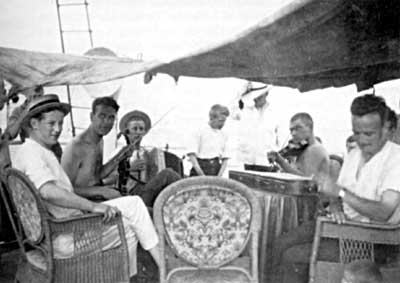
There was much disquiet amongst the 83 persons aboard Albemarle, but when the orchestra played on the foredeck, even the most quick-tempered calmed down. The violinist to the left is the 6'7" tall man from Ålesund, Molvin Knutsen, later the head of the fishing group in Wreck Bay. The wicker chairs were purchased in Madeira. Photo courtesy Robert Ødegård.
“September 6: Hans Lunde is up early, shaved and well dressed. Three days ago he was forty years old; now they will celebrate the day in a manner befitting a promising businessman from Oslo who went bankrupt but wants to start again on new ground. He is a fearless chap with a buoyant stride and carries his head high, never hesitates when something has to be said. After a good dinner all gather for coffee around a long table with musical instruments: an accordion, two violins, two guitars, one saxaphone and a drum. On the coffee table are bottles with red and golden labels. The “Coffee-Doctors” § taste good, spirits are rising, music pipes up, and soon there is exuberant dancing across the deck. At the table next to mine, a game of poker is accompanied by shouts and bets sufficiently salty to make the innocent blush. The dancing becomes heated and wild, there is stamping of feet, juicy jokes fly through the air. Eyes are shining, breathing is heavy. The married men do not like it. They gather up their women and prepare to leave; they know their responsibility. The dancing dies down, the men start hitting their bunks, still grumbling and swearing.
§ Norwegian equivalent of Irish Coffee.
“There comes the galley-boy § with steaming teapots and calling ‘supper!’ The chaps jump or roll out of their berths to the dinner table, a wild commotion. Three men are there already, trying to get hold of the same teapot. The bread baskets are empty in a moment. Half a dozen knives meet in the same butter dish. The cream jug is dancing back and forth like a spinning top. Five to six blackened fists dip into the sugar bowl. Norwegian cheese moves like a ball across the length of the table. Plates and cups rattle and clatter, knives cut and scrape, and lip-smacking and slurping can be heard.
§ The galley-boy job was divided among the men.
“Finally, stomachs are filled, and one after another they lift their legs over the bench and find their way to their berths, tumble into them, puffing and panting. The pipe is lit, and smoking and low grunting noises are heard until eyelids close, the pipe falls out of the mouth, and snoring begins. One man is asleep on the floor. Finally, there is quiet. Only now and then a child's cry is heard through the wall.”
Unfortunately, it is soon evident that there is a core of eight to ten trouble-makers aboard Albemarle, chaps who seem to lack tact and consideration, and are more interested in partying, drinking and fighting. Alcohol is locked away in the provisions room and is distributed in small rations in order to avoid drunkenness. But this arrangement was known before departure and those who are not enthusiastic about this kind of guardianship have prepared strategic hiding places for their bottles and jugs.
Albemarle is lucky with the weather, but even with the wind dead astern, she advances slowly and is passed by absolutely every motorvessel, large and small. Randall is annoyed:
“It is scandalous that a multimillionaire like Arthur Mathiesen would sell a ship to an expedition such as ours when he must have known that her maximum speed is only 6 to 6½ nautical miles per hour.”
September 19. At last, Albemarle drops anchor in the port of Las Palmas. Randall would have liked to proceed at once, but the Finnish engineer, Musikka, recommends a new water cooler for the engines, and this operation takes time.
At the same time 80 tons of water are loaded at 4½ pesetas per ton. Twenty-five tons of diesel fuel, which comes from England, is paid in British currency and costs 87 shillings 6 pence per ton. In addition to vegetables, fruits, and four sheep carcasses, Randall makes sure to purchase whiskey—Dewars White Label—for 7 pesetas a bottle.
There are others who also consider alcoholic beverages inexpensive. Randall writes in his diary that on the first day ashore, he “returned aboard at 4 p.m. and from that time on there was much noise and drunkenness. At 2 a.m. the steward comes aboard and reported that the second mate Lund was arrested and fined 25 pesetas (about 24 kroner). There was no quiet until 4 a.m.”
And a few days later:
“Again this evening there was a lot of noise from drunken fellows. These are the same 8 or 10 who drink all the time and are rowdy. The third mate Bjørnstad is the worst. This afternoon he came up on the bridge where I stood, used vulgar language and threatened to beat me up. We had visitors, the captain and first mate from one of Wilhelmsen's ships. Also present was a German engineer working on the engines.
“The noise continued all night on the foredeck, with screaming and shouting, and as time passed, several more returned from shore—drunk—and made their contribution to the racket. The captain had to interfere several times, which helped somewhat. They continued until bright daylight.”
The town's newspaper has a writeup about the ship with the vino-loving Norwegians. Several are arrested or brought aboard by police escort. There are sighs of relief, both ashore and aboard ship, when Albemarle finally leaves the quayside. According to Austlid the departure is not without problems:
“Finally, one afternoon, the ship is about to cast off. Steam is applied to the capstan, but things are badly rusted and the steam escapes. Joints have to be be tightened and we try again. Meanwhile, the pilot impatiently paces up and down on the bridge, and the captain had to appease him with several drinks. But at last, towards evening, the anchor is up clear and we slip out of the port of Las Palmas. We feel much relieved when we are once more at sea bound for the Panamá Canal.”
The episode was much more dramatic than described by Austlid, because when the anchor finally was weighed, the engines stopped. With the big anchor and ten-meter chain hanging from the bow, the vessel drifted quickly towards the quay with the pilot signalling feverishly for a tug boat. At the last moment Musikka got the engines going but the anchor came fully up only when the ship was on her way out of the harbor.
Randall perspired at the thought of expenses related to tugboats and salvage money and what else may occur before the end of the voyage. They only had sufficient cash for the most necessary expenses in the Panamá Canal.
Sailing westward presented no great problems either with ship or weather. The trade winds were strong and steady and the ship often made 160 nautical miles in 24 hours. However, there were plenty of other problems to tackle en route.
Arthur Worm-Müller and Rolf Mathiesen, who were chosen to monitor the expedition's financial resources, presented their report on October 1. It contained not only a statement of accounts but also a total condemnation of all that the administration had done. They also made a strong personal criticism of Harry Randall, accusing him of having managed the expedition for the sole purpose of personal gain. Finally, they referred to descriptions of Galápagos which pointed out that the land was without water, was dry and scanty, and unfit for colonization. Randall was accused of withholding such information in order to heighten interest in the expedition.
From Randall's diary, October 4:
“Today there was a large meeting on center deck where, on behalf of the Executive Committee, I replied to the accusations of the so-called accountants Worm-Müller and Mathiesen. Their claims grabbed at everything possible between heaven and earth, including fraud and embezzlement. As Mathiesen read aloud from his long memorandum, one by one their charges and complaints in duplicate and triplicate, were rebuffed. It was Stray, Andersen and I who replied, depending on which subcommittee each accusation was directed to.
“Pettersen, Clasén and Digerud also spoke and defended themselves against a number of harsh and unsubstantiated charges regarding planning and purchasing. The meeting ended with Muribø moving a vote of confidence in the administration. The motion was carried, with eight votes to Mathiesen. With this the Executive Committee is cleared and the feelings aboard ship are considerably improved.”
The meeting apparently dampened the tempers for some days ahead. On Friday, October 8, Randall writes:
“My appetite is much better now, as the entire mood aboard ship has changed in favor of the administration. I hope that once the expedition has arrived, I can abandon my work with the majority recognizing that my role has been executed well and honestly. I regard it as absolutely impossible to please everyone and gain unanimous approval. There are far too many ambitious persons who believe that they could have done so much better themselves. The ship was referred to as tangible evidence that the administration did not understand our tasks. But she maintains her steady speed, is excellently seaworthy, and is so big that there is ample space for 83 people. Truly, the weather has very much favored us; for example, we have not yet had a single breaker across the deck. Small children, one year olds, move about freely and up to now have never been restricted in their wanderings around the ship. Under a protective awning on the foredeck, cards are played around a table. Every day they play the entire afternoon. There is plenty of space up there for twenty people, indeed, even more!”
Randall's only complaint during the next few weeks is about the “bedbugs and other insects,” which bite and pester him during the night. The further west they go, the warmer it gets; more life in the bedding!
Randall shares the cabin with Captain Deetjan who is persecuted by the same insects in his bunk. They often have to escape on deck during the night, despite attempts to get rid of the pests with several kinds of insect killers. In desperation, Randall takes his berth on deck and sprays it with kerosene. But a few nights later, the problem is just as troublesome again.
Well through the Panamá Canal—which they reached on October 22—some discussion arises as to whether or not they should touch port in Guayaquil or sail directly to Galápagos. Worm-Müller is very keen to first take the ship to continental Ecuador. He has his doubts about Galápagos, and argues that they must check out conditions in Guayaquil first. But the last of the money is spent, and they have only sufficient fuel to take the ship from Panamá to Galápagos and back. The old plan of putting Albemarle into regular service was put aside long ago, and at the present time it is important to get the ship back to Balboa or Panamá City as quickly as possible, and, hopefully, execute a favorable sale. With only five votes in favor of Worm-Müller's proposal, it was decided to sail directly to Galápagos.
The last two days before departure on October 26, they are anchored off Panamá City. Austlid summarizes his impressions of the place:
“The town is like two worlds. One a heavenly realm with beautiful houses in shady palm gardens where the whites live dressed in their white tropical attire. And one hellish counterpart where the blacks live like animals in a pigsty.”
During the last days of the voyage, new committees are chosen that will administer transportation of equipment to shore, form hunting and fishing groups, and administer the construction of houses.
Fourteen small houses have been prefabricated, numbered and disassembled at Vippetangen Quay. Each of the 78 expedition members are assigned to a house. The old executive committee must still be on reasonably good terms with each other because Randall is due to live with Stray, Andersen, Pettersen and his two sons, as well as Miss Pauline Hjorth.
Another task before disembarkation is that of distribution of tobacco, which appears to be at least as important as normal food. Accounts at the time of departure from Oslo illustrate this point:
Expenses for provisions: kroner 3,398.90
Expenses for tobacco: kroner 1,428.48.
Snefrid Guldberg was secretary of the Albemarle expedition, and made a list of shareholder contributions. Years later, she wrote a circled “død” (dead) next to the names of those who had passed away since the list was prepared. Photos by the author.
| Randall Expedition Members who Moved to the Galápagos Islands May 22nd, 1926. | ||
|---|---|---|
| Member | Amount | |
| Thorleif Guldberg and 3 children | Kr. 12,000 | 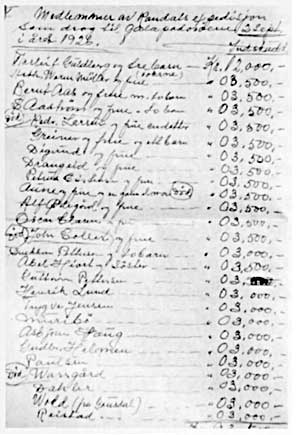 |
| Worm-Müller and wife | 3,500 | |
| Bernt Aas and wife and 3 children | 3,500 | |
| S. Aastrøm and wife and 2 children | 3,500 | |
| Larsen (dead) and wife and 1 daughter | 3,500 | |
| Greiner and wife and 1 child | 3,500 | |
| Digerud and wife | 3,500 | |
| Drangeid and wife | 3,500 | |
| Petrus Gustavsen and wife | 3,500 | |
| Aune and wife with child | 3,500 | |
| Alf Ødegård and wife (dead) | 3,500 | |
| Oscar Claan and wife | 3,500 | |
| John Boller (dead) and wife Søller | 3,500 | |
| Vidkun Pettersen and 2 children | 3,000 | |
| Abel Hiøst and sister | 3,500 | |
| Katherine Pettersen | 3,000 | |
| Henrik Lund | 3,000 | |
| Trygve Jensen | 3,000 | |
| Muribö | 3,000 | |
| Asbjørn Haug | 3,000 | |
| Gundrun Halvorsen | 3,000 | |
| Paulsen | 3,000 | |
| Wassgard (dead) | 3,000 | |
| Dakler | 3,000 | |
| Wold (from Gausdal) | 3,000 | |
| Reistad | 3,000 | |
| K 93,500 | ||
| Renstad from Gausdal (dead) | 3,000 |
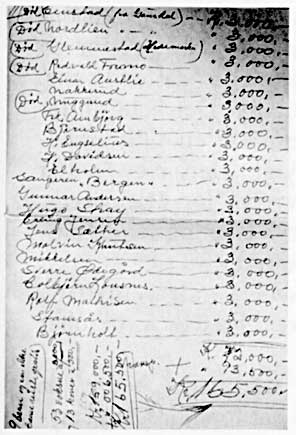 |
|---|---|---|
| Nordlien (dead) | 3,000 | |
| Glemmestad (dead) | 3,000 | |
| Radvald Fremo (dead) | 3,000 | |
| Einar Austlie | 3,000 | |
| Nakkerud | 3,000 | |
| Nuggerud (dead) | 3,000 | |
| Frk (Miss) Ambjørd | 3,000 | |
| Bjønstad | 3,000 | |
| H. Engselius | 3,000 | |
| H. Davidsen | 3,000 | |
| Elkholm | 3,000 | |
| Sangeren (singer) “Bergen” | 3,000 | |
| Gunnar Andersen | 3,000 | |
| Hugo Stray | 3,000 | |
| Erling Jensen | 3,000 | |
| Jens Sæther | 3,000 | |
| Malvin Knutsen | 3,000 | |
| Mikkelsen | 3,000 | |
| Sverre Ødegård | 3,000 | |
| Colbjørn Lonsen | 3,000 | |
| Rolf Mathiesen | 3,000 | |
| Stamsås | 3,000 | |
| Bjørnholt | 3,000 | |
| K 72,000 | ||
| + 93,500 | ||
| K 165,500 | ||
| Summary: | ||
| 9 children and an elderly lady traveled free. | ||
| 53 grownups @ K 3,000 | K 159,000 | |
| 13 wives @ K 500 | K 6,500 | |
| K 165,500 |

